#revised version of a previous post based on the scene this is based on
Explore tagged Tumblr posts
Text
Sandra Lynn: From now on, we'll be using code names. You can address me as "Eagle One". Sandra Lynn: Gorthalax, codename: "Been there, done that." Sandra Lynn: Jawbone is "Currently doing that" Sandra Lynn: Hallariel, "It happened once in a dream" Sandra Lynn: Sklonda, codename: "If I had to pick another parent" Sandra Lynn: Gilear is "Eagle Two" Gilear: Oh thank god
#revised version of a previous post based on the scene this is based on#by previous post I mean one I made less than 24 hours ago#anyway bad parents polycule dynamics my beloved#dimension 20#fantasy high#sandra lynn faeth#gorthalax the insatiable#jawbone o'shaughnessey#hallariel seacaster#sklonda gukgak#gilear faeth
240 notes
·
View notes
Text
Overview of TGCF Versions
Due to recent(ish) events, I thought it would be good to make another post cataloguing all the different "versions" of TGCF, for newcomers and old fans alike! I'll also be going over some FAQs that I've seen or been asked so this post can serve as a decent info thread.
For simplicity's sake, first think of there being two "main" version of TGCF:
The Original -- what all the translations are based on, as well as the manhua and donghua.
The Revised -- what was released in print last year in China (only), and what was recently updated on JJWXC. The audio drama is adapting this
The original webnovel was itself not "censored." By that I mean, it contained everything MXTX originally wrote including kisses, swearing, innuendo, etc. MXTX did self-censor to avoid Real Censorship (hence the lack of NSFW scenes we may have gotten like in her previous novels), but that's a whole different thing. For all intents and purposes, consider the original version and (most of) its translations as being uncensored.
The revised version was first publicly released as a print novel in China. As such, it was actually censored. While "Hualian" is still there, and things are alluded to, it's a lot more vague. Kisses and a lot of other things were cut, including certain dialogue tidbits that perhaps were deemed a bit too obvious. (Plus a lot of Feng Xin and Qi Rong's cursing was removed lmao.)
HOWEVER, shortly after the print release, the audio drama started adapting the uncensored revised version. So we all knew there was an uncensored revised version somewhere in existence. It wasn't until the end of last month that we actually saw it! TGCF was available again on JJWXC after years of being "temporarily locked" to comply with regulations. (Though it was possible it was locked for other reasons. We will never fully know!) Not only was it finally unlocked, but it was actually updated to the uncensored revised version!
F.A.Q.s
1.) Why did MXTX make a revised version anyway? MXTX has mentioned before that she was not entirely satisfied with the original version of TGCF. Because she wrote and released each chapter in a serialized manner, with frequent (possibly daily?) updates, it doesn't surprise me that it didn't turn out exactly how she wanted. Now that she has the opportunity to sit down with it and go over everything on her own time, she's able to get it closer to what she wanted. In short: she's just really passionate about this story!
2.) Is there and English translation, or will there be? What about other languages? Officially, not yet. We don't know if there ever will be, as MXTX would have to re-negotiate the rights with publishers for translations, and at this time, we don't know if that'll happen. Unofficially, there are a few options: a. ClearNoodle has done some fan-translations you should check out here! b. By purchasing the webnovel on JJWXC now, you can MTL (machine translate) the novel. If you've seen screenshots in English floating around that aren't part of the fan-translations above, this is probably the source.
3.) What is JJWXC and how do I use it/purchase TGCF on it? JJWXC is the webnovel publishing site where TGCF was originally released. It hosts a giant array of C-novels, including most other danmei that you may have heard about. SV and MDZS were indeed also on JJWXC, but are currently (still) locked. To purchase TGCF (or any other novel) on JJWXC, cangji.net has an excellent guide and list of other helpful links to get you all set up. Please do check it out! Additionally, buying on JJWXC seems to be the most direct way to support authors. You can also throw bonus tips at them!
4.) How much has really changed in the revised version? A fair bit. Mostly, the changes are to do with plot structure, minor characters, overall flow, and so on. It's still essentially the same story, but in a way that feels fresh. Hualian in particular have exactly the same dynamic as before. MXTX added extra scenes between them, including very sweet and tender domestic stuff haha! There's also a few new lines of spicier dialogue to go along with some of the scenes that already existed in the original.
5.) So what is considered canonical? Both, in a way. MXTX has stated that she's happy if fans can enjoy both at once, and that we're free to pick-and-choose as we wish. Personally, while there are many things I prefer from the original, the revised version is something closer to MXTX's true vision for the novel. So I feel that holds a little bit of weight there, too.
6.) Will the manhua/donghua be adapting any of the newly revised content? So far that seems unlikely. The revised version facelifts a lot from the early parts of the story, which is stuff these adaptations have already covered. It would be hard to change things down the line now. At most they could add some of the extra dialogue or such, but we'll see if that's the case. For now, we simply don't know and shouldn't count on it. If you'd still like an adaptation of the revised, please absolutely check out the audio drama! It's easily become my personal fave adaptation of the story, and is made by a small but very passionate team who are close to MXTX. Thus, it's quite faithful and does the source material such justice! <3
#tgcf#tian guan ci fu#hob#heaven official's blessing#this post was supposed to be out WEEKS ago but such is life lol#nyerus.txt#guide
124 notes
·
View notes
Text
Adachi's imaginary dick waving contest with Namatame
This is a revised version of a post I wrote very during the infancy of this blog. It is being split into smaller posts.
...I didn't intend to leave the name "Adachi's imaginary dick waving contest" but it was my one sentence draft and it stuck.
On a previous post, I talked about Adachi being the figure who shows up in the fog in the Central Shopping District on the dungeon deadlines, and how the dates he appears compared to when the first threatening letter shows up at the Dojima house would indicate that his claim about "watching an epic game of cat and mouse between the Investigation Team and Namatame" was bullshit. Chronologically impossible bullshit.
I propose that, instead of this, he was actually trying to screw over Namatame and ruin that dude's life.
Adachi's behaviors before the reveal
Aside from how Adachi is presented as not being wholly truthful during the December 7th dialogue, I think it's also worth pointing out that something doesn't add up about his "cat and mouse" claim when you look at his other behaviors.
After Mitsuo is rescued and brought into police custody, Adachi will appear at the Dojima house and bring up the possibility that the killer is still out there. He even does this again when Naoto turns up.
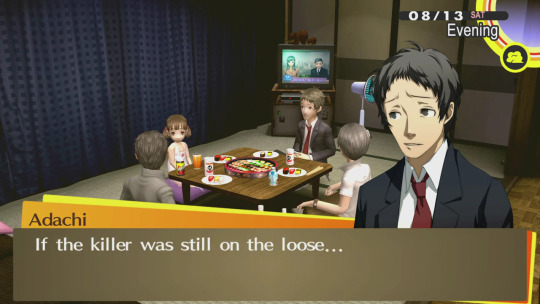
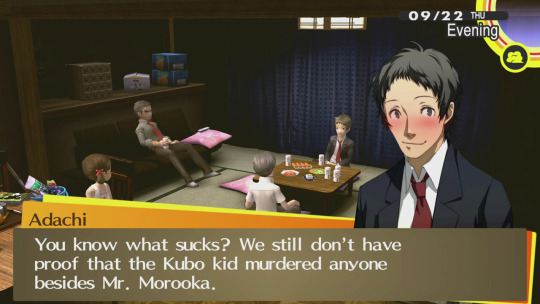
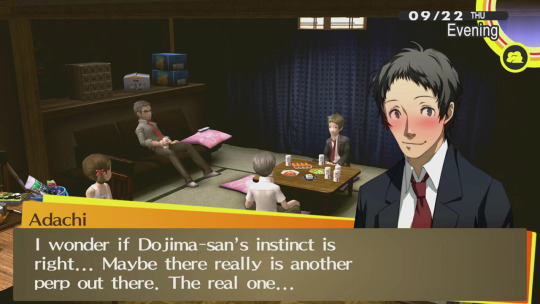
If you know he's the actual culprit, this might make it seem like he's taunting the player. I have also read an interpretation that he says these things because he wants to be caught, which from my understanding is based on the psychology of real world serial killers.
But while people bring these lines up, they fail to notice how after Namatame comes into the picture, Naoto finds Namatame's journal, reads out that Mayumi and Saki's addresses are in Namatame's journal, and then Adachi says, "that settles it".
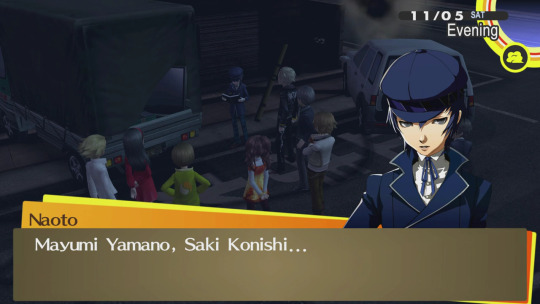
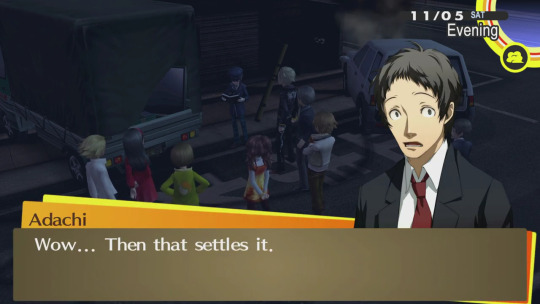
If Adachi wants to be caught, why is he saying, "That settles it" in response to his murder victims addresses being in Namatame's journal?
He's even shown taking Namatame's case so seriously that Dojima thinks it's out of character for him as Adachi has been consistently characterized as a slacker up until now:
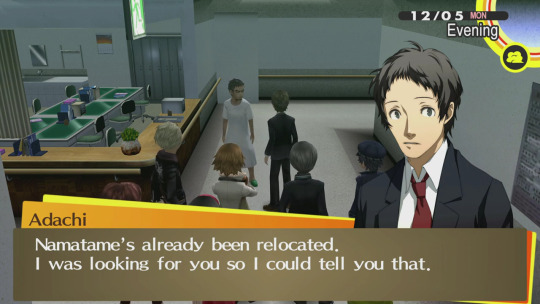
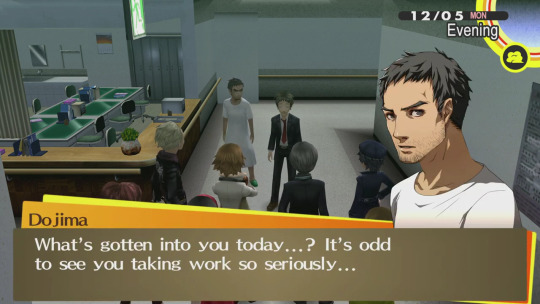
Furthermore, Namatame's transfer was foreshadowed. And if you follow the scenes, he was transferred because of the IT. In fact, the IT even knew about the transfer, they just didn't realize it.
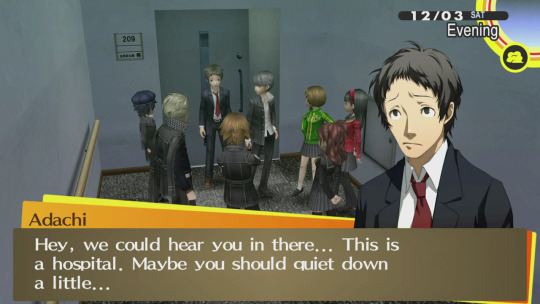
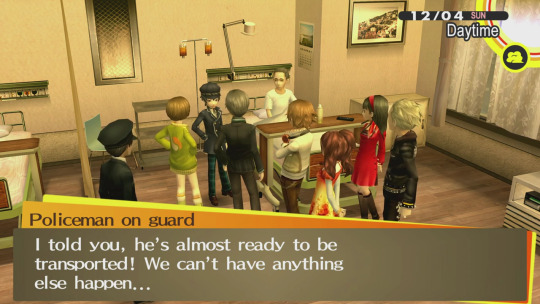
On December 3rd, after the IT become the Seekers of Truth, they go outside Namatame's hospital room and talk about everything he just said. The IT are starting to believe that Namatame didn't do it, and Adachi overhears their entire conversation.
The IT returns on December 4th to question Namatame, and on their way out, an officer reveals that they are preparing to transfer Namatame. We know from December 5th that it's Adachi who orders the transfer, and it comes up on December 4th, the day after Adachi overhears the IT talking about Namatame not actually being the murderer. Hmm. What a coincidence.
I don't think anything with how Adachi approaches Namatame's hospital stay suggests "Adachi was trying to get caught" or "Adachi was trying to facilitate a game of cat and mouse" or even that "Adachi was bored and doing a little silly". The "game" of cat and mouse would be over at this point -- even if Namatame gets freed, why the hell would he go back to abducting people into TVs? Especially now that other people are aware of his actions?
Asking the "why"
At this point, I think it's worthwhile to start ask a bunch of obnoxious questions.
We know that Adachi is the real murderer, we know he nudged Namatame to go kidnap people under the guise of "saving" them, we know he put Kubo into the TV himself, and we know he sent the threatening letters. But for what reason?
If he's merely trying to get away with murder, why would Adachi throw Mitsuo into a TV to begin with instead of just letting him take the fall? Why, in the scenes discussed in the last part, is he openly talking about it being someone other than Mitsuo? Again, we can infer from his response to Namatame's journal that he is not trying to get himself caught.
We know he claims that he's watching a game between Namatame and the Investigation Team to alleviate his boredom. But if that's so, then why does he send the threatening letters to the Dojima house at all? People in the fandom explain this as him trying to rile up the Investigation Team. If he's understood what's been going on since the start and he was merely trying to rile them up, why does he wait to do so until after Naoto's dungeon? Wouldn't the time to rile them up be after they bring in Kubo, when they think they've won and think the case is over...?
I have also seen people explain this as, "Adachi just wanted to see more dead bodies". If Adachi wanted to see a dead body so badly, why not go chuck someone else into a TV himself? The only person he was willing to do this to, beyond his first two murders, was Mitsuo. And only after Mitsuo turned himself in, claiming to be the murderer. Not even in the bad endings where the calendar skips to March 20th does Adachi throw another body into the TV.
Furthermore, why does Adachi only shut up about a "real murderer" being out there after Namatame is captured, and rush to get Namatame relocated after people start asking him questions and figuring out he might not actually be the murderer?
Adachi claims to be bored, did it cause he could, watching a game unfold between Namatame and the IT. But doesn't Adachi's amusement go away if Namatame is jailed or dies and quits "saving" people?
Adachi's timeline leading up to December 5th, and how "Fuck Namatame" explains a lot of his actions
I think assuming that Adachi is being driven by a Namatame Hate Boner of sorts fills in a lot of the gaps and why he does and says certain things.
At the start, it's the part that's straightforward: Adachi kills Mayumi and Saki, takes Namatame's phone call, and recommends he "save" people.
Adachi says on April 17th that he knows people show up on fog nights. He then shows up on the April dungeon deadline expecting a body because he had told Namatame to go put a person in a TV. There is no body, and he goes "..." in the fog. Maybe Namatame got cold feet? Repeat for Kanji. There's no dead body. In the fog, Adachi asks, "Again?"
The police find Morooka's body. After two fog nights where no body appeared, Adachi thinks Namatame has finally killed someone. But Kubo turns himself in. This is not who Adachi wants to get arrested for the murders, so he gets rid of Kubo by throwing him into a TV.
The Investigation Team rescue Kubo and show Adachi that someone can be rescued from the TV. Chie makes a point of saying Adachi was there when they handed over Kubo, so Adachi both knows that Kubo is out of the TV, and that the IT might be related.
After Kubo is rescued, the police are going through with the investigation, but Adachi says, "Gee it sure would suck IF THE REAL KILLER WAS STILL OUT THERE..." because the guy he wants to get arrested, didn't get arrested.
Then Naoto goes missing. When Naoto returns, Adachi once more brings up the "real murderer" thing again when he's at the Dojima house. As Kubo's investigation carries on, it starts becoming obvious to the police that Kubo only killed Morooka, which Adachi also brings up during this convo.
On Naoto's deadline, Adachi appears in the shopping district at night. This time he says, "Dammit. Again?!" Last time, the IT showed him that a person *can* come out of the TV. Hmm... Kubo came out of the TV, and there's no body again this time... Is it possible that... Bodies have been going in... But coming out... This whole time...? :mind_blown_emoji:
The next fog night is coming up on November 20th. Adachi wants Namatame to produce a body, and he has guessed the IT are why he has failed to produce one yet. Adachi sends the threatening letters to the protagonist on October 20th and November 5th, hoping it will make you back off so Namatame can finally kill someone.
I imagine his game plan from April to November was to somehow get Namatame to kill someone, then get him arrested from this; perhaps a situation he thought he'd be able to manipulate on the police side if he knew who did it.
Later on November 5th, the Investigation Team all gather in the interrogation room and, in front of Adachi, explain that Namatame must have been abducting all of them with his delivery truck.
Naoto reads Namatame's diary which fortunately had both Mayumi and Saki's addresses in it. At this point, Adachi must think he's in the clear, and he goes, "That settles it". Everyone thinks Namatame did it and it's looking like he'll take the fall for Adachi's murders because of the addresses in the notebook.
At this point, I think Adachi began trying to get Namatame convicted for the murders of Mayumi and Saki. The notebook was a huge boon.
On November 21st, Adachi tells the IT that they can visit Nanako at the hospital. But before he leaves, he also tells them that they've been looking into Namatame, and he says, hey guess what? Namatame had been hitting on Saki. We know later that Namatame didn't actually do that, but Adachi is trying to keep up the narrative about Namatame.
On December 3rd, Adachi tells the IT he isn't sure if the charges against Namatame will stick, once again trying to keep up the narrative. When you think about it, even if Namatame were to die that night, it'd be assumed that he is the Inaba Serial Killer, and the truth about Adachi would never come to light. It almost works, even, but the protagonist gets everyone to calm down. Later on December 3rd, Adachi overhears the IT outside of Namatame's room and realizes they're starting to figure it out.
On December 4th, after the IT finish talking to Namatame, a uniformed police officer enters the room, tells them to get out, and says that Namatame is being prepared for transport. Meaning after realizing that the IT are still investigating after overhearing them on the 3rd, Adachi quickly organized Namatame's transfer before they can ask him more questions and figure something out.
And lastly, in the bad endings, where time skips from December to March, no more bodies have appeared because either Namatame is dead or on trial with people assuming he murdered Mayumi and Saki. If another dead body shows up, then it will call into question if Namatame is really the murderer.
But why Namatame?
Tbqh I think he was just jealous of Namatame's rizz.
Mayumi's death is portrayed as an accident. Adachi knew he could touch a TV, but he had no idea a whole body could go in, and threw up when he saw her corpse. Saki's death was 100% him being a power tripping asshole, having learned what happens with Mayumi. And both of these women, his victims, had someone in common: Namatame.
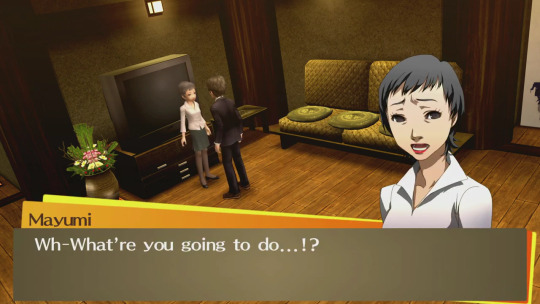
While this is not shown directly in the game, we can infer from context that Adachi saw Mayumi on the Midnight Channel at some point. And we know from Namatame's flashback that Mayumi did appear on there. What's more is that the rumor about the Midnight Channel was that you see your soulmate.
It seems likely that Adachi, new to Inaba and depressed / lonely / sad boi mode after being transferred, heard about the Midnight Channel (probably from Izanami), watched it, and saw Mayumi. What he didn't know was that everyone saw Mayumi - she was on people's minds because of her scandal. But he got something of a teenage girl hyperfixation on this real woman, thinking it was meant to be. And when he gets a chance to meet her, he does not react well to her and Namatame actually being an item.
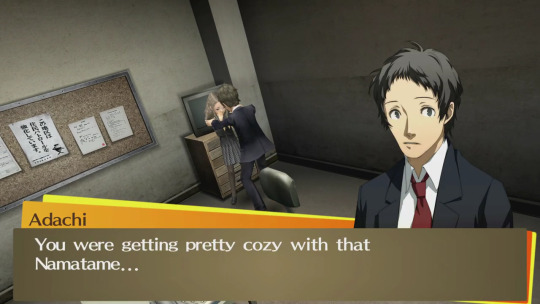
Then, he goes after Saki, but he only targets her because of Namatame. He's shown in a flashback trying to force himself on her while mentioning that he saw her this afternoon with Namatame. She stands her ground and slaps him away, and he makes a face while saying that being with him is no-good but being Namatame is fine, huh?
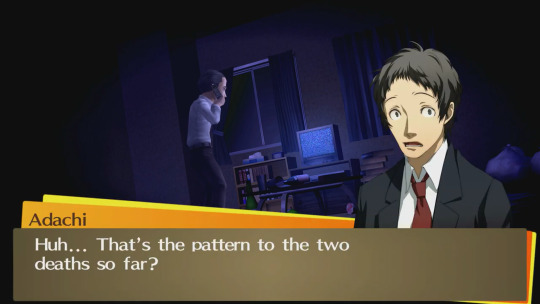
Finally, Namatame himself calls the police and says he saw Mayumi and Saki on the Midnight Channel, they both turned up dead, and now he sees another girl.
I think Adachi's real game began here with this phone call. He's the real killer and he knows that people in the TV die and turn up on foggy nights. By telling Namatame to put them "somewhere safe", he is trying to get Namatame to accidentally kill someone.
And it's not just the Mayumi and Saki stuff. I think there are a couple other reasons why Adachi might be bitter about Namatame...
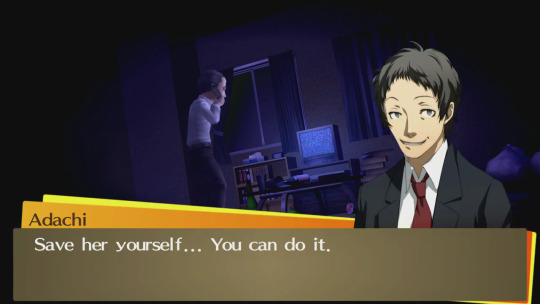
First, magic powers. What's unclear about the phone call scene is if Namatame told Adachi about Magic TV Powers. Namatame knew he could touch the TV because he did it when he saw Mayumi on the Midnight Channel. The game seems to have left this intentionally vague since the phone call only begins after Namatame has already explained everything to Adachi, but I think Namatame did say something about it. Adachi knew at the time that a whole body could go inside, and something about what Namatame said might have prompted Adachi to suggest Namatame put people where no one can find them.
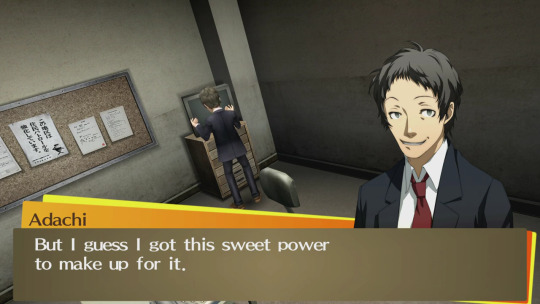
Why does this matter? Well, Adachi seems to like his Special Power. How do you think he felt when he found out that he isn't very special, and that it sounds like Namatame can do the same thing?
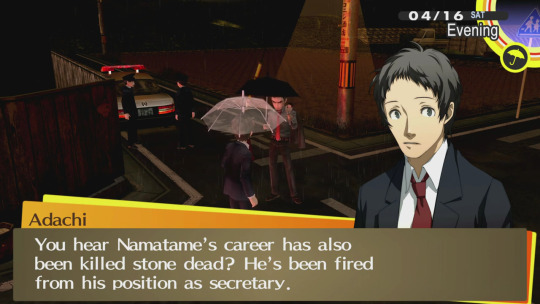
The next one is related to something I wrote the other day about how Adachi's views towards having a government job might a product of the economic clusterfuck of 1990s Japan. Further down in the post, I went into each of the Investigation Team members, and how Chie is probably the only person who would be able to relate to Adachi in any form. Everyone else is either already famous, or, if their careers fail, they have their families to back them up.
But this doesn't just apply to the Investigation Team. Namatame is a government employee who loses his job due to the scandal... And yet he's still chuggin' along. He moves back home, and he gets a job working under his parents as a delivery driver. Adachi, to our knowledge, doesn't have something to fall back on or inherit from his parents if he loses this job. (I think this is implied by how his parents hounded him to study and sent him to college prep.) Not only did Namatame take his soulmate, but this fucker wasn't even completely ruined.
You can see his actions as like... He's trying to get Namatame to kill someone, he's trying to get Namatame framed for his own murders, he's trying to get the Investigation Team to kill Namatame. Adachi doesn't talk about Namatame much, honestly, but wowie I get the feeling that he really fucking hates this guy. Adachi is just so, so hilariously pathetic here. Like he thinks Namatame cucked him, so he's simultaneously comparing himself with Namatame and trying to ruin his life. Jesus dude.
tl;dr
I think Adachi has a raging hate boner for Namatame, spawning from him being Mayumi's boyfriend and his assumption that Saki was with Namatame
Namatame also having TV powers and Namatame being able to fall back on his parents probably added to the fuel
A lot of Adachi's actions seem to form a coherent timeline if you assume he was trying to get Namatame to kill someone at first, then later tries to get Namatame convicted for his own crimes after the diary is found
#i think adachi needs to watch the barbie movie and learn that he is adachinough and doesn't need a lady on his arm#nor does he need to compare himself with other men#also what the fuck do you mean this is 2700 words and 15000 characters#persona 4#tohru adachi#adachi brainrot#persona 4 golden#p4#p4g#taro namatame
45 notes
·
View notes
Text
A simple guide to how Kuwana uses honorifics - Lost Judgement (Revised)
This is a revised version of a post I wrote previously - I made a few errors so I decided to make a new post instead of just adding on to the original, especially since a few people said they wanted to use this as a reference for comic or fic writing in the future.
Please note that much of this is based on my own interpretation and should not be taken as pure fact. Japanese is a context-heavy and nuanced language - so I am simply building off what I already know about Japanese [culture] (I live here!) as well as my own idea on what type of character Kuwana is. Actually, I think Kuwana is strangely polite - all things considered - so the way he refers to other people is mostly unsurprising.
I also want to note that just because one honorific means one thing does not mean that interpretation is universal. The use and meaning of honorifics change depending to who you're speaking to as well. For example, many people may know that -kun is used for younger boys, and -chan for younger girls, but language is much more nuanced than that. While honorifics can be used to "honor" someone (imagine that!) they can also be used flippantly, sarcastically, aggressively, or even to put someone at a lower position than you.
You can see a previous analysis on how he refers to Mitsuru here. For that reason, he will not be included in this post.
Thanks for reading!
with Yagami
Perhaps the one people are most interested in. Most of the time, both Yagami and Kuwana drop honorifics with each other entirely. A cursory glance at Wikipedia may tell you that this is only used for people with close relationships or for inferiors (fittingly, like a teacher with their student) but in this case, it is neither of those things.
They drop honorifics with each other, simply, because they do not respect each other. Although there are other instances in which you can drop honorifics with another person (see: above, my original Mitsuru post, or read further) when Kuwana isn't referring to Yagami by name - which is very often - he is using 「お前」 (omae) or 「あんた」 which are very forward, rude ways to refer to someone. When someone uses 「お前」 with you, it usually implies they are angry with you.
However, there are a few occasions when Kuwana uses honorifics with Yagami. In the scene where Kuwana is hanging out at Y99, he uses -san.

This is a simple formality because they are not yet rivals or enemies. In retrospect, you can also interpret this as Kuwana using -san sarcastically or passive-aggressively, but honestly I think he's too polite to be doing that so early-on.
Other instances in which Kuwana uses -san with Yagami are when he is speaking about Yagami to another person:


There are two ways you can look at this: these are both formative scenes in which Kuwana is trying to coax empathy from Yagami. Using -san rather than "OMAE" would, of course, be the more respectful way to address someone - especially after you've made a temporary truce with them. The other way - this is how I originally interpreted it, which is why it wasn't in my original post - is that, because Kuwana is speaking about Yagami to another person, he is using the honorifics the person he is speaking with should/would use when addressing Yagami. Meaning, Kuwana is asserting that it would be appropriate for Akaike or Mamiya to use -san with Yagami - not himself.
Aside from that, Kuwana also uses -kun with Yagami once. Originally, I thought it would be strange for him to ever use -kun despite Yagami being younger than him. However, he does!
In Chapter 7, after Kuwana leaves Yagami to fight RK alone, he says: "I'm sorry, Yagami-kun."
-kun, in this case, is being used out of familiarity - not sharing the same politeness or formality as -san. I think Kuwana said it more to himself and not directly at Yagami - in a meta way, this assures the viewer that their relationship has changed. This was a rare sign of compassion (perhaps respect?) from Kuwana: I believe in part because Yagami showed that he believed in fighting for Kuwana - even if he was not given the context as to why RK was after him. Also, Yagami was fighting to defend Sawa - someone Kuwana deeply cares about.
with Kaito
To be honest, I'm not sure why Kuwana doesn't use honorifics with Kaito. I could have sworn he used -san with Kaito once, but I can't find it. Forgive me. And, don't call me hypocritical for saying this, but I don't think dropping the honorifics with Kaito is the same as dropping them with Yagami.
The only reason I can think of is that Kaito asked for Kuwana to not use honorifics with him (like, off camera). Some people don't use honorifics for themselves because they believe it to be old fashioned. I think in this case, it says more about Kaito than it does Kuwana. He wouldn't be doing 呼び捨て (yobisute - dropping honorifics for someone who you have a close relationship to) because they aren't very close.
Conjunctionally related, the reason why Yagami uses -san with Kaito is likely the same reason why Kaito calls him Ta-bo - they have been calling each other that for a long time, and it has become part of each other's nickname.
with Y99
Kuwana uses -kun with both Sugiura and Tsukumo. Sugiura even refers to Kuwana as their "senpai" since they do similar work in the same area - this is a joke, though. Grown men do not normally refer to each other as senpai - Sugiura and Tsukumo are both younger than Mitsuru, so it's hard to believe Kuwana would honestly see them as real adults.
with Sawa and Mamiya + a bit about former Kurokawa students
I talked a little bit about this in my other post, but he uses -kun with them. Using -kun with adult women is a formality. It's the same reason why Genda uses -kun with Saori - though, their relationship is a bit different. It's kinda... old fashioned I think? There's an implication that, "even though I'm using a formality with you, we aren't totally equals.". That's because Saori is a younger woman working at Genda's law agency.
Using -kun with girls/women is different than using -kun with boys/men - especially in a school setting. While using -kun can be seen as a bit boyish, from a teacher to a female student, it's similar to using -san; and the reason why -san isn't used for male and female students (by teachers) is partially because it's a little too formal between a child and adult. Yeah, I know. Japanese is hard.
Therefore, it's natural he might use -kun for his former female students, because, ultimately, it is up to a teacher to decide how, when, and who to use honorifics with. For the same reason, Akaike is referred to without honorifics (unlike Mitsuru, who is almost always referred to with -kun). Kawai's honorifics are also totally dropped, perhaps for the same reason, but I also think it's because he is dead and Kuwana has no intention of humanizing him. The reason for that being: Reiko does this as well!
with Kusumoto Reiko
Kuwana is a Kusumoto-san bot almost as much as Yagami is with Sawa-sensei. Since she is older and their relationship is a bit strained and distant, Kuwana uses her last name and -san. Reiko returns the formality in an interesting way, referring to him directly as "Kitakata-sensei" because that is how she knows him as. However, during the emotional climax, she refers to him as "Sensei", which is sort of an endearing formality that indicates respect and ...love? Not necessarily romantic, but a certain fondness or gratitude - as normally, students would refer to their teacher as "Sensei", not necessarily student's parents or their fellow coworkers. (I do have one older female teacher who calls everyone else just "Sensei" and it makes me blush, lol) I know that's less about how Kuwana refers to her but I think their relationship is not as stiff as it may seem based on what honorifics they use with each other.
That seems to be a correction of everything from the original post. If you have any questions or would like me to expand on some points (whether it's confusing to you or seems contradictory), feel free to reply and I can answer you or alter the wording for clarity.
*A note about "omae":
Part of what makes writing posts like these extremely difficult is because everyone is characterized by the way they speak, and the way they speak is the typical RGG rough-and-tumble "tuff guy" act. Therefore, I want to clarify that omae is not always extremely rude. Rather, it is the tone, level of familiarity, and even gender that characterizes it as rude. For example, there are instances in which Kaito uses omae with Yagami, but that's because their relationship is established enough that using omae does not immediately set off alarm bells for Yagami. That makes it different for when Kuwana uses it, because he is more-or-less setting the tone of their relationship as distant and competitive right off the bat. Hope that makes sense. Thanks to @passthroughtime for the previous corrections as well as the screenshots I use in this post, lol.
#internet: only grown men use ore#my elementary school students: hold my juice#this post is long as shit but im trying to get rid of any nuance because reading between the lines is hard#i will link the original post to this one as well so ppl who reblogged the first one can maybe see this as well#kuwana jin#yagami takayuki#kaito masaharu#lost judgement#rgg#yakuza#text#idk what order i should tag names in. hopefully this will be found by people.#sugiura fumiya#tsukumo makoto#kusumoto reiko#sawa yoko#character analysis#analysis#ok tags over
25 notes
·
View notes
Text
Spy x Family CODE: White new trailer and predications
A new teaser trailer for Spy x Family CODE: White was just released! While a lot of the footage is the same as previous trailers, there were a few new notable scenes, which I screenshot below:
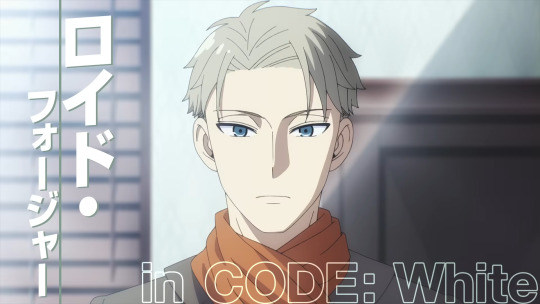



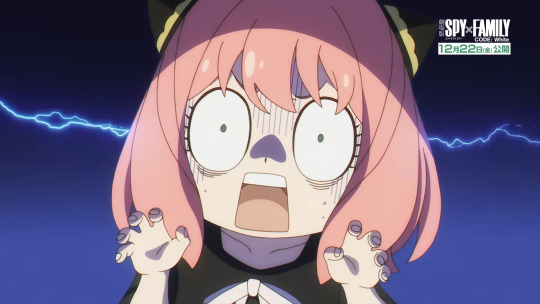
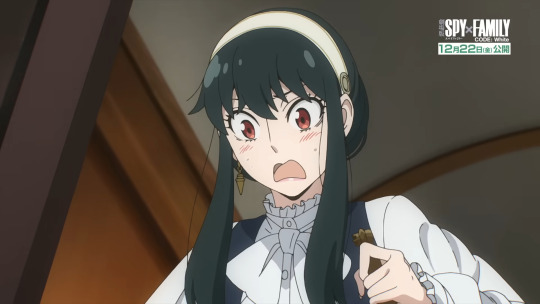
youtube
If you haven't seen already, I made a very detailed post with my predictions for the exact chronology of events in the movie, based on the trailers and information we've gotten so far. So give that a read first since the predictions I'm about to make here from this new trailer are based on that:
-Firstly, the man in the photo in the second screenshot is the man that will supposedly be replacing Twilight for Operation Strix. Previously I thought Twilight may have gotten this information from the rolled up note he's seen catching in the first teaser trailer. But since this trailer actually shows him meeting with Sylvia, I'm now theorizing that the rolled up note is instructions telling him where to meet her. I also now think that Sylvia will be in at least two scenes: this one, and later on with Fiona and the other agents when discussing the microfilm.
-And secondly, the new scene with Yor is very telling. She's holding the key that Anya had used to open the trunk with the chocolate. If you read my aforementioned predictions post, there was a scene with Yor from the other trailers of her seemingly fighting someone indoors, and I couldn't tell if it was inside the train or somewhere else. However, with this new scene of her holding the key, I'm pretty sure the fight scene is on the train. What threw me off is that she's wearing the lipstick during this part, which she got after the Forgers visit Frejis, which I thought occurred after the train ride. So now I'm thinking that the train ride takes place after they visit the shops in Frejis and is the train that will take them to the place that they're staying, where they eat the Frejis cuisine. Yor discovers that Anya had run off somewhere while on the train (and finds the key), she sees the bad guys interrogating or perhaps attempting to kidnap Anya after she ate the chocolate, and proceeds to give them some "mama bear" punishment. I still don't think Anya's actual kidnapping happens here as other scenes don't align with that.
The trailer also has a new line of dialogue from Yor where she's telling Loid that something happened to Anya. Now this could be during the train scene I just discussed, or it could be later when Anya is kidnapped for real (since the dialogue in the trailers don't necessarily match the scenes being shown). My predication was that Loid and Yor work separately to save Anya, but maybe they at least confirm with each other that something happened to her? 👀
Anyway, I'm as excited as ever for the movie! (and finding out how many of my predictions were right/wrong 😅) Depending on how much new information/trailers we get in the next month before the movie's release, I may do a revised version of my predictions post.
#spyxfamily#spy x family#spy family#sxf#sxf anime#loid forger#yor forger#anya forger#sxf movie#spy x family code white#sxf code white#sxf spoilers
81 notes
·
View notes
Text
The master post of my Nevermore analysis
This post has links to all the extensive reviews I've written about Nevermore (webtoon) so it doesn't get lost in the depths of the internet. I'll update it as I write more and I'm going to try to maintain some degree of order in this mess.
Another detail: if you see that some of these reviews contradict each other or are not entirely consistent with each other, it is because I write them as the comic progresses, so it is very possible that one or more of them end up being outdated, but anyway I think it's worth keeping them.
An unnecessarily detailed analysis
These are practically vignette by vignette revisions of certain scenes or moments of the comic.
An incessantly detailed analysis of the (re)encounter between Annabel and "Leo"
An unnecessarily detailed analysis of the (re)encounter between Annabel and "Leo" (part II)
An unnecessarily detailed analysis of Lenore's face when she realizes how gay she is
Literary analysis
Reviews of Nevermore from the perspective of literary theory.
Nevermore is a gothic tragedy. Part I: Classical and Shakespearean Tragedy
Character Study
These are character analyses. Some of them could fit in the previous category, but I decided to leave them aside because they are much more specific.
Annabel Lee Whitlock: The Hypocrite, the Vampire and the Femme Fatale. A review of archetypes
Lenore Vandernatch: the rogue, the gothic heroine and the courtly knight. A review of archetypes
Montresor is the Bad Ending of White Raven
Montresor is the Bad Ending of White Raven II: Electric Bogaloo
Montresor (and Willtresor) is the Bad Ending of White Raven III: now it is personal
I think the Deans are fucking Lovecraftian gods
Nevermore themed cocktails
Fun fact: I'm a cocktail/mixology aficionado, here are some cocktail recipes based on Nevermore.
Note: the knowledge required for the preparation of mocktails is very different from the knowledge required for the preparation of cocktails. Therefore, while I may occasionally upload non-alcoholic versions of these cocktails, I may not always have the skills to make the transfer from one to the other.
Harlequin
Posh Besties
Stolen Moments
Stolen Moments (mocktail version)
The box of cookies (which has no cookies)
Here's basically whatever nonsense I've burned more time on than I should and don't want it to go to waste.
A detailed explanation from my headcanon that Annabel has ADHD
43 notes
·
View notes
Text
✨Weekly Progress 2024 #18-21✨
oh... shit, it's been a month since the last update huh 💦
Well, I hope it's very obvious why that is! In the few weeks before the announcement, I was preparing marketing posts and promo arts so I didn't want to ruin the surprise via a devlog!
Weekly Progress #18
Programmed SYVNH gallery
Made a programming to do list
Updated variables
[Fan project] Planning
Tested SYVNH main game, Side B
Programmed cheat codes
Programmed choice jumping
Made marketing plan and sketches
Updated SYVNH Guide
Drafted Post Mortem
Refined countdown sketches
(SYVNH as a whole project was finished at this point)
Weekly Progress #19
Fin 4 Promo art
Generated 14 SFB BGs
Tested SFB shading methods
Rendered Avia SFB sprite
Play tested for Canvas Menagerie
Scheduled SYVNH announcements and promo posts
Rendered Raven SFB base sprite
Wrote 981 words for KHP
(SYVNH full game release announcement was made at this point)
Weekly Progress #20
Rendered Raven SFB sprite
[Fan Project] flat color (x4)
Worked on [BL RPG] world building & outline
Sketched [BL RPG] chibis
Revised SYVNH Guide/Post Mortem
Sketched [BL RPG] faces
Weekly Progress #21
Drafted SYVNH game page updates
Finished Dove SFB sprite
Evaluated SFB fight scenes
Finished 4/4 [fan project] illustrations
Started P^3 designs
Released SYVNH!! 🎉🎉🎉
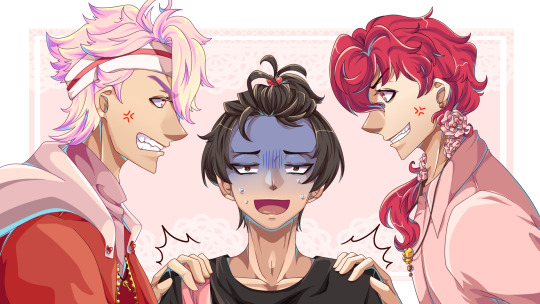
I'm sure everyone knows with how often I've been saying it, buuuut!!
The full version of Stuck in a Yandere Visual Novel...HELP!! is now released and available to play for free!!
Itch is currently down for me so I hope that link I copied from previous posts will work once it goes back up.
At 2.5 years of work, this has been my longest creative project yet. I think I've said everything I could in the post-mortem for the project. It has been a huge mountain for me to climb and I'm glad I finally got through it. A lot of things have changed since I started working on this project, some good, some bad, most of which I can't really discuss. But it is over and I am proud of myself for it.
I'm also really relieved that folks have been enjoying the ending! I was definitely very worried that I did not drop enough hints and it would come way too out of left field.
So once again, thank you everyone for giving my project a chance and sticking with me for 2.5 years to reach the ending. Thank you so much!! 🙇♂️🙇♂️ This is more than I've ever dreamed for and I hope I can continue to bring good stories for folks to enjoy!
A Sky of Falling Birds
Once I was done with SYVNH, I got to work on my next big project because I can't sit still. I haven't a marketing plan for SFB yet. It's a very different story and vibe from SYVNH. I think the only similarity are the length of the main character's bangs.
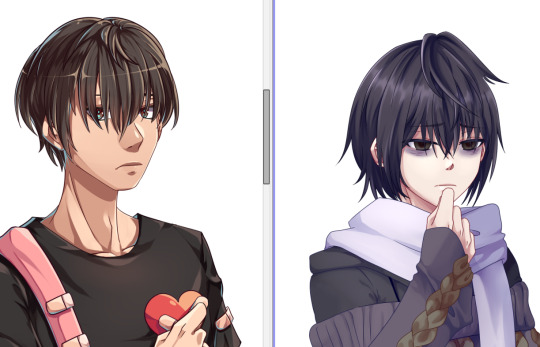
I'm tentatively aiming to release SFB for BAF VN Jam.
(Ad break!
Do you like shounen manga?? Do you like making VNs?? Consider joining Battle Action Fantasy Visual Novel Jam 2024! We're hosting a game jam focused on action stories with our beloved shounen tropes!! Join today!!)
Oh god that was terrible, don't put me on the spot like that, me.

Anyways, A Sky of Falling Birds is a yuri-ish visual novel about depression, finding a will to live, and the end of the world.
It's yuri-ish because you have two "love interests" who aren't lovey-dovey to you at all. In fact, one of them might murder you before the game ends. The main portion of the script has been finished at about 20k+ words and the sprites are done. It's time I made a proper roadmap for creation of this VN('s demo).
(Oh, what's that? Does one of their silhouette look familiar? I wonder...)
A Variety of Unnamed BL Projects
+ a named not-BL project
Although SFB is closer to being finished, I can't help but be tempted by these new ideas I have... and start designing for them.
Last time I talked about P^3, I finished the outline. There is still no title. But I worked on some potential designs for the MC and the two LIs.

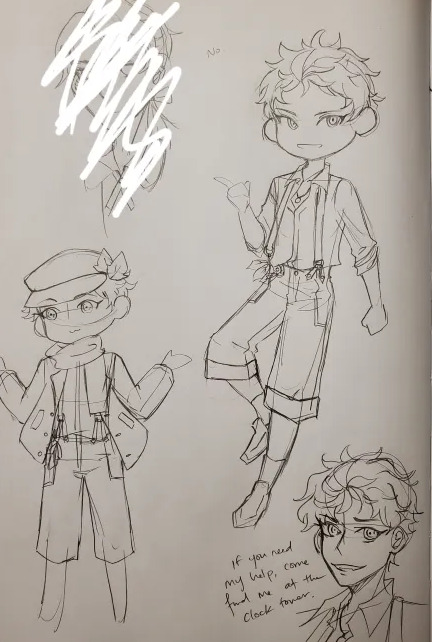
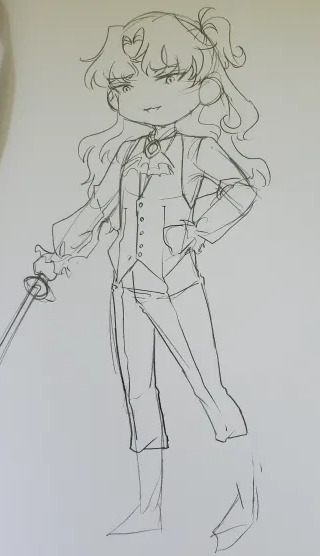
I am both unhappy and un-done with LI2's outfit. They're actually a bit plain compared to my other designs, but this story's a historical (Victorian) fantasy and only LI2 is close to the upper crust of society that would wear flowing dress... shirts with lots of ribbons.
I'm still working on how to best summarize this story. But perhaps it's a little more "what would you do for family" than love story.
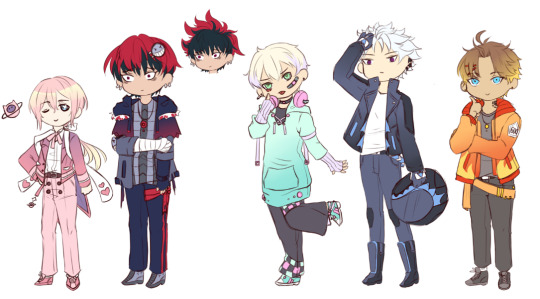
The other BL project, which I've named [BL RPG] is a story set in a modern fantasy society. There is turn based gameplay for this project. I had their designs finished a while back, but I finally put colors to the remainder of the cast for Part 1.
(Oh, this will be a long one, my friends...)
The outline isn't done yet.
This is a story about kissing boys, taming punks, and maybe over throwing the government.
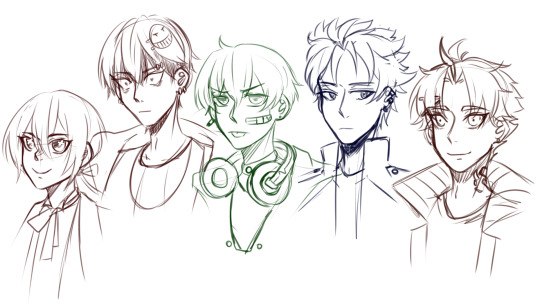
The last of my "projects I worked on mindlessly now that SYVNH is done" I worked on this past... month is Killer Hiding Place (KHP). This is the next entry into the Kill Series and something I had outlined since last year. I kept trying to start writing it, but I keep running into trouble on how I want to tell the story. I originally intended to do another manga-esque format like that of Exorcist Killing Lie, but this protagonist tends to monologue a lot, making it difficult to put in manga form.
Other...!
I finished 4 images for a fan project, and I'm still behind on another part of that project 😢 That'll be my focus for this week...
I also did some playtesting for @arimiadev's upcoming BL visual novel Canvas Menagerie!! It's a soft and comfy SoL BL story about the struggles of being an actor.
It also has one of the best lines I've ever read in a visual novel.
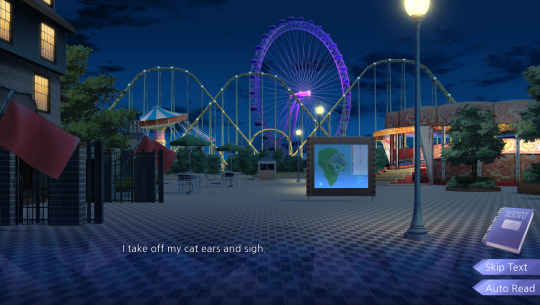
You can play the Canvas Menagerie demo for free on itch!
Whew! That was a long one!
But that's all the info I got for this... month. Look forward to... next week...??? Let's go with the positive expectation that I will be able to make weekly devlogs again ahaha...

Bye-bye, Pumpkin out!
8 notes
·
View notes
Text
The History of Korean Girl Groups' evolution over time - Before Liberation to Girls Generation (SNSD) -> Part 5
In my previous post about the Pyongyang Kisaeng School i talked about the history of the school and how it ran before and after the Japanese colonial period, there is a discussion on Reddit about Kisaeng's (Here) and does mention a famous Kisaeng called Jang Yeon Hong (장연홍;張蓮紅), she was THE Kisaeng of her era (1920s).
Book Recommendations:
Numerous books and manga explore the fascinating world of Kisaeng, shedding light on their significant role in Korean history. In my earlier discussions about the History of Korean Girl Groups, I mentioned how Kisaeng used to perform collectively, although they were not labeled as Girl Groups back then. However, the current trend is to categorize groups of female performers as Girl Groups, showcasing a shift in perspective towards viewing Kisaeng as the precursors to modern Girl Groups.
By delving into the rich history of Kisaeng, we gain a deeper appreciation for their cultural impact and influence on Korean society. The evolution in how we perceive Kisaeng, from traditional performers to early versions of Girl Groups, reflects a changing narrative that recognizes their contributions to the entertainment industry. Through various literary works and artistic representations, the legacy of Kisaeng continues to be explored and celebrated, offering valuable insights into their historical significance and enduring legacy.
Manga - Cheon Gwan Nyeo (천관뇨)
While trying to find some books on Kisaeng i found this manga called Cheon Gwan Nyeo its about how she is the royal Kisaeng (Geisha) of King Jin-Pyeong, who lived in during Silla Dynasty (between 57 BCE – 935 CE), and that the poetic general Kim Yoo Shin falls in love with her. If anyone is manga lover give this a try, its by JO Mihyeon.

Kisaeng Story - Book
If anyone whats to know more on Kisaeng's I would sagest reading the Kisaeng story by Shin Hyeon-gyu which was published in 2007.
As it published in 2007 some of the information that is mentioned in this book could be outdated as new information could have been found that was not mentioned in this book or more information could have been found in recent years, i personally have not read it yet but i would give it a read.
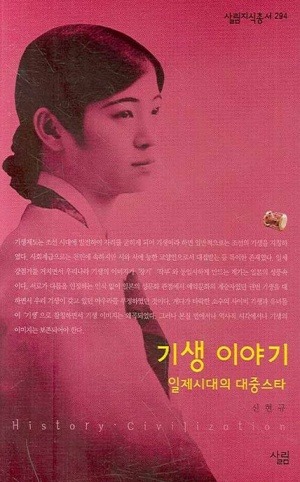
Book introduction - During the Japanese colonial period, Kisaeng's were, on the one hand, objects to be rejected as feudal relics, but in reality, they were heirs to traditional arts and music culture and stars of modern popular culture.
Since modern times, the image of Kisaeng has been distorted as a small number of corrupt pseudo-Kisaeng's and courtesans refer to themselves as 'gisaeng'. This book introduces the original image of gisaeng, who were the successors of rites and music and popular stars.
Index: The history of Kisaeng in Korea, China, and Japan. Finding the whereabouts of Gwangi. The birth of Gwonbeon and the years of glory and shame. A gisaeng is born as a popular star. A visit to Pyongyang Kisaeng School . An encounter with a Kisaeng, confusion over the identity of the space.
Hankyoreh Music Dictionary Set
Book Introduction - Published in 2012 the 2 volumes of the Hankyoreh Music Dictionary Set by Song Bang-song, professor emeritus at Korea National University of Arts. It was prepared based on the author's 《Korean Music Terminology》 written in 1979 and the 《Hankyoreh Musician's Dictionary》 written in 2012.
After revising and supplementing 《Korean Music Terminology》 to reflect recent research results, we carefully selected important figures from among the figures introduced in 《Hankyoreh Musician Dictionary》. It contains terms directly or indirectly related to Korea from ancient times to modern times and provides explanations.
Kisaeng Training Center

Pyongyang Kisaeng school class scene.
The emergence of Girl Groups can be traced back to the Pyongyang Kisaeng School, which was a prominent institution for female performers established in 1926. This school played a crucial role in shaping the education and training of female singers and dancers, providing them with the necessary skills to succeed in the entertainment industry.
Just like how modern audiences eagerly anticipate the debut of new Male and Girl Groups, the demand for gisaeng education in Pyongyang was high during that era. The establishment of the Pyongyang Gisaeng School aimed to meet this demand by offering a structured and comprehensive curriculum that covered various aspects of traditional performing arts, as well as general education subjects.
The impact of Kisaeng Schools and training centers extended beyond just providing education to aspiring performers. These institutions also laid the foundation for modern traditional performing arts education by offering specialized classes in traditional singing and dancing, as well as other art subjects. The structured curriculum and focus on meeting social demands of the time through education are reminiscent of the current approach to art education, highlighting the enduring influence of these early educational institutions.
1930s - The birth of Korean Girl Groups
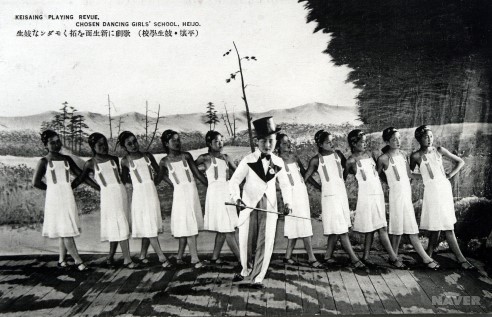
I did already show this picture before of the Pyongyang Kisaeng School students practicing a revue dance to the music of a modern musical instrument. There many other photos of students that went the school, if anyone is interested here is the link (Old School Photos).
During the Japanese colonial period, Kisaeng's were assigned to theaters such as Wongaksa (웡각사) Temple and Danseongsa (단성사) Temple and emerged as 'popular stars' by performing for the public.
Wang Soo-bok (왕수복), Seon Woo I-seon (왕수복), and Lee Eun-pa (이은파) were popular singers from Pyongyang Gisaeng School in the 1930s. They performed during a transitional period in Korean domestic popular music history. As jazz and Western dance were introduced in the 1910s, Kisaeng's dances changed from classical to Western, resulting in the revival dance. The roots of girl groups during the Japanese colonial period can be traced back to Kisaeng's group dances and choruses, which were influenced by Western popular music and transformed into modern people.
During the Japanese colonial period, there were numerous performances by the Kisaeng's, which were recorded in an article titled "Cultural Archetype Encyclopedia Korean Modern Music." As I was perusing through this article, I came across a Performance Log that provided a timeline of events. The Performance Log ranged from 1 to 45 and documented the first appearances of Kisaeng's. The earliest mention of Kisaeng's that I could find was in Performance Log 9, where the Hanseong Kisaeng Association made an appearance on April 1, 1909, at Hwangseong. Subsequently, they appeared in Performance Logs 10 and 11, but it was in Performance Log 13 that they made numerous appearances. On March 27, 1913, the Gwanggyo Kisaeng Association performed at the Danseongsa Temple to support the midwife training center. Following this, the Sigok Kisaeng Association performed on May 13, 1913. On August 31, 1913, the Gongju Kisaeng Association showcased various songs and dances. Lastly, the Pyongyang Kisaeng Association performed songs and dances on October 9, 1913. The list of Kisaeng groups that performed or made appearances goes on, and I would suggest that anyone interested should delve into the Performance Log list and read the corresponding articles. There is a wealth of information to be discovered, as these logs mention numerous Kisaeng performances. By exploring these articles, one can gain a deeper understanding of the cultural significance and contributions of the Kisaeng's during the Japanese colonial period.
All sources that i used and found are attached are underlined.
9 notes
·
View notes
Text
Note about my last post about Tappy's translation of the ending of 109
I seemed to have upset a few people with my last post when I said it was a mistranslation. To reiterate, due to the nature of the Korean language, with how it doesn't really use standard pronouns like the English language, and context is heavily implied, I was pointing out my dissatisfaction with how Tappy definitively selected certain pronouns. So basically, if you read it in Korean, although vague, you could assume that Tory was saying these things, because she's the last one to say something. (So yes, that's correct) However, if you were to reread 109 in Korean, after seeing chapters 110-111 after seeing how badly Rupert reacted, with his sheer desperation, how his world absolutely collapsed and shattered, how heartbroken he is, the context immediately changes. And when you consider the context of the 114 post I posted a few posts ago, contextually, it becomes evident that those words were foreshadowing Rupert's suffering and regret, not Tori's.
Because Tory knows what will happen:
Lari will regret hurting Rupert through her death. If Rupert never accepted Lari, he wouldn't have fallen in love with her and thus suffer so much when he finds her - a part of him does regret meeting Lari and developing these feelings, but still, even if it hurts him, enough for him to feel like dying, he will continue to love her. Meanwhile, when readers reading the ENG version revisit the scene, it's gonna look weird because the next scene she appears in, Tori is mocking Rupert and rubbing salt in the wound and saying "I told you so" yet in this scene she's apparently regretting that SHE was the one who shouldn't have met Lari?? TORY. YOU'RE RIGHT THERE. STOP LARI FROM DOING THE STUPID THING. Again, Context is key.
.. but hey, if you like tappy's version where Tory is more human, go ahead. Readers can decide what version they like better.
— Ah. I also wanted to point out that since this is an official version, where they translate chapters chronologically, we get what we get, with no revisions to previous chapters. If this was a scanlation done by fans, then yes, they would have done what tappy did by having Tory be the subject in the initial release, but after 101-111 is released, would make a 109.5 version or a Translator’s note with the correct context with those pronouns referring to Rupert as I mentioned. It’s just a shame that ENG readers have this “lost in translation” experience. This is what I meant by YM being a difficult read in the sense that it’s so heavily based on context ^^; I tried to help out by giving the correct context but guess it confused people.
4 notes
·
View notes
Text
Hello. We are Arthromutability, a transformation-based audience participation game. We run on a modified version of the To Change system, found on itch.io here. This is a beta post - a test of the intro, to be revised and reposted until the game actually starts. You can feel free to follow now, of course - but be aware that the game may not start until much, much later.
Current story: [ARTHROMUTABILITY HAS NOT YET STARTED]
HOW IT WORKS:
Once per week, we will post a story post - this will be a short story entry, ideally accompanied with an illustration. We will accompany this with a set of drawn cards, and a decision - you. the audience, will pick a card, and we will continue the story from there. We will not tell you what these cards do - you must, rather, figure out what you're doing from what happens from picking a card.
We take suggestions on actions via ask, comment, tag, or addition to the post - we reserve the right to refuse or alter suggestions as needed, as our priority is staying true to the story, not to the letter of the ask. We appreciate constructive criticism and are happy to answer questions on our decisions - some things, however, will remain hidden until the story concludes.
As this is, of course, a narrative about transformation and change, our avatar will change along with our current character's state. There is a character sheet behind the scenes, but you will not see it until all is said and done - the machinery ticks, but the curtain will not be pulled away until what it fuels is finished.
Past characters may be pulled back for a reprise, but it is more likely to be starting from a relatively blank slate than it is to be a straight continuation of a previous story. These things are, as always, up to vote.
There are likely to be delays. We ask for your patience - Rome wasn't built in a day, and we are not a fast worker.
2 notes
·
View notes
Text

Commissions on Ko-Fi
Contact: @karthonic (Personal Blog)
Other Links: karthonic @ linktree
Please read below for more information regarding commissions.
I reserve the right to refuse any commissions I do not believe I can fulfill.
Commissions are made for personal use. This means you can use them for social media (icons, banners, etc), or printed for yourself to be on display in your private spaces, or in the case of logo work, for business cards, letterheads, social media sites. You cannot resell copies of the for your own profit, or sell as NFTs.
However, I am willing to discuss commercial licenses if that is what you want. (Prints, but not NFTs.)
Please be advised the additional character price is for adding to the scene; if you want two separate character portraits, they should be considered separate commissions.
Payment is not expected until a sketch is approved. You will get three free revisions, and any further revisions will be charged a $5 revision fee for each further revision.
What I Will Do:
Original Characters
Canon Characters
Non-humans/Aliens
Animals
Cheesecake/Pinups
Ship Art
Things I’m Willing to Try:
Anthropomorphic Characters/Furries
(Detailed) Mecha
Object Heads
What I Will Not Do:
Explicit Gore of any kind
Explicit Pornography of any kind
Art based on Real Person Fiction
References:
Please be generous with references! Character sheets, previous artwork, and ideally a set color palette for hair/skin/fur/etc. If you do not have one already, feel free to use some of these sites to generate one: Coolors, Colormind, colourlovers, Paletton, Encycolorpedia, Color-Hex, Rapid Tables, rgb.to, and plenty more. Looking through stock sites for poses and sending the low res images help too!
I will always prefer visual references like the ones above over text based descriptions. However if you can try to send a few along with text based descriptions I will try my best with what I have, but be aware additional revisions may be needed.
Deliverables:
All files were designed for web with RGB color profile; be advised that in printing colors may change. If you intend to print it out please let me know so I can set the file out for CMYK.
Portraits:
One Version of the file as a print quality PDF (most at-home or on demand printers can use this file)
One Version of the file as a high quality (300 DPI) PNG (for personal use or for on-demand printing)
Version of the file watermarked as a web quality (72 DPI) PNG (for use on posting/sharing on social media– I will also being using this version when I post on mine)
Icons/Chibis/Logos:
One Version of the file as a high quality (300 DPI) PNG (for personal use or for on-demand printing)
One Version of the file watermarked as a web quality (72 DPI) PNG (for use on posting/sharing on social media– I will also being using this version when I post on mine)
Expanded EPS file for resizing at will
Graphics/Branding:
Files will be the highest quality following the respective social media site’s guidelines
PSD/EPS files for future editing
PDF “Style Guide”
For All Vector Art: Should you need a different size, you can contact me any time for a resize of your commission. I will extend this to my digital painting but I cannot guarantee it can be exported without any issues.
Payment:
All prices are US Dollars. If you’re not American and need an exchange rate, feel free to use this currency exchange tool here.
Once the sketch is approved, I will ask for your payment info and coordinate from there.
Tips can be made through PayPal, Venmo, or Ko-Fi.
Posting:
I have the right to post my work on any of my social media; it will be a lower web resolution piece with a watermark and not the original file. Please let me know before I post whether or not you wish to be tagged and what account I should tag when I post.
Likewise, please credit me when posting art, you can use either my tumblr (@karthonic), Cohost, Instagram, or Ko-Fi (all karthonic)
0 notes
Text
Fun Facts About “Wabash Valley Devil”

As you read in my previous post, I had a short gothic horror story included in the “Tales of Fear, Superstition, and Doom” anthology by Redwood Press. It’s called “Wabash Valley Devil.” You can buy a copy of the anthology here. The Kindle edition is available now, the print edition will be available soon. Now, onto the fun facts/behind the scenes info about my story.

“Wabash Valley Devil” is set in the 1830s, in the Wabash Valley in Indiana. I didn’t specify what town it is based in, but you can safely assume it’s not too far from my home town of Terre Haute and within what is now known as Vigo County.
The main protagonist is a devil that terrorizes the valley. Its name is never revealed; the Wabash Valley Devil title is merely what the locals call him.
Indiana has many, many legends, folklore, haunted happenings, and gothic tales, which have influenced some of this story. But the devil in this tale is inspired by both the legends of the Bell Witch and the Jersey Devil.

Tosca Lee’s “Demon: A Memoir” had an influence on “Wabash Valley Devil.”
One of the characters is named Damaris. I imagine she resembles Dame Eileen Atkins as she did in “Cranford.” I’ll never be over dear Deborah Jenkyn’s death on that show.

When I was a teen, I was a huge fan of the revised Millie Keith series. It was a Christian historical series based in Indiana in the 1830s…There was a character named Damaris in the novels and obviously I borrowed the surname of Keith.
Damaris is a character in the Bible. She is mentioned in Acts 17:34: “Howbeit certain men clave unto him, and believed: among the which was Dionysius the Areopagite, and a woman named Damaris, and others with them.” I posted the King James Version because it is the version those in this story would have read.
My original draft of “Wabash Valley Devil” was, in my opinion, darker. But the editor of the “Tales of Fear, Superstition, and Doom” Ann van de Bergh encouraged me to make the story more redemptive and in many ways, evangelical. So special thanks goes to Ann!
Until next time!
#wabash valley devil#tales of fear superstition and doom#redwood press#gothic fiction#horror fiction#speculative fiction#historical fiction#indiana
1 note
·
View note
Text
Steven Universe: End of an Era: Outline & Review
I wrote this review in October but never got around to posting it here
Steven Universe: End of an Era is far more than an art book–it’s also a collection of behind-the-scenes material, stories about the experience of working on the show, planning documents and associated background info, and both older versions of developed concepts AND concepts that never made it into the show. It's a huge fusion of all those elements, and it's definitely an experience!
Some low-quality images are included with my review just to give you an idea of what’s there--it’s not a good substitute for getting your own copy, but here’s a tour!
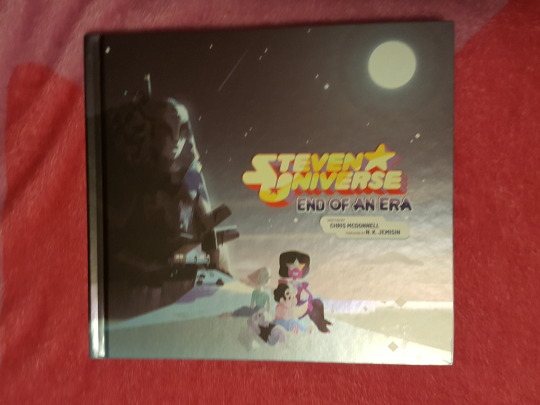
Like the previous concept art book, Art and Origins, I'll be giving you a description of the structure and overview, while also collecting notable information for fans. Obviously just about everything is "notable" once again, but I'll aim for unique insight or perspective on the main source material, keeping the screaming about everything new to a minimum so you can also enjoy something for yourself if you pick it up. My low-quality photos should prevent people from feeling like I'm reproducing the book in any capacity. Please grab one while you can and have your own experience!
[SU Book and Comic Reviews]
OVERVIEW
The book is titled "End of an Era" for a couple reasons--obviously because it is released after the show has wrapped, but also because Gem history recently ended its "Era 2" and began Era 3--an age of prosperity and peace. The author--the person in charge of adapting all of this information into this slick, readable package--is Chris McDonnell, whose work was previously applied on the Art and Origins book.
The foreword is by N.K. Jemisin, a well-known science fiction author who's a huge fan of the show (and wrote a really excellent series that also has a weird geological connection, by the way).
And the cover, like its predecessor, is shiny and decorated with a beach scene featuring minimalistic characters--this time it's the Gems at night in front of the Temple, and on the back cover is a big pink leg ship in a cross-legged pose.
The interior covers are decorated with tons of amazing sketches of Steven and Connie on the front, and a bunch of Gem sketches on the back. Every interior page that most would leave blank is highlighted with some kind of sketch art or character exercise--it's so much to look at, so much to absorb.
The book is dedicated "For Eddie."
Its organization is different from the previous book in that it shares applicable work in chunks associated with groups of episodes rather than pertaining to different aspects of building the show.
FOREWORD
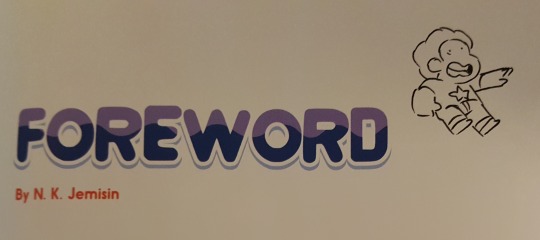
N.K. Jemisin gives us such a great introduction to the book--apparently understanding very well that the audience of this book is full of animation enthusiasts and adult fans more than it is full of kids, and explaining that bewildering journey some adults had from blowing this show off as a silly kid thing to falling in love with it hard and fast.
The important thing, Jemisin says, is being able to trust a storyteller with your heart. And it was clear to her that Rebecca Sugar knew what she was talking about and was saying important things about identity and the radical power that comes with accepting it and demanding respect.
Important also is how we handle heroes and who gets to be one in fantasy. That's part of the reason Steven Universe speaks to so many--because we see ourselves here, and know stories can be about us. Acknowledging the power we all have to MAKE THINGS BETTER with what we fight for is so important--especially if we're going to speaking to the next generation about it.
Highlighting Rose Quartz as a "born leader" who failed and Steven as a relatable scamp who did what she couldn't, Jemisin asserts that we can save the world.
1. END OF AN ERA
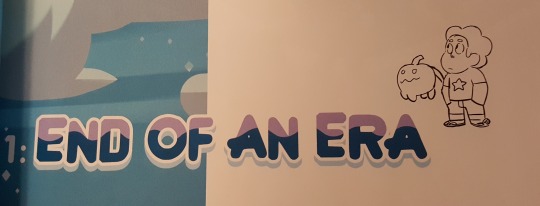
We start with an appeal to the audience to think about identity and the formative parts of our childhood--and how different it is if who you are and who you become is restricted, mocked, erased, or Not Allowed. Most people, if not ALL people, can relate to this, but for those of us with a special relationship with Steven Universe because of queer identity, this hits hard.
But it doesn't have to be anything grand to be something we respect--this show's authenticity comes largely from how personal everything is, drawn from real-life experiences and incidental truths from each artist's perspective, leaning hard on childhood and formative experiences.
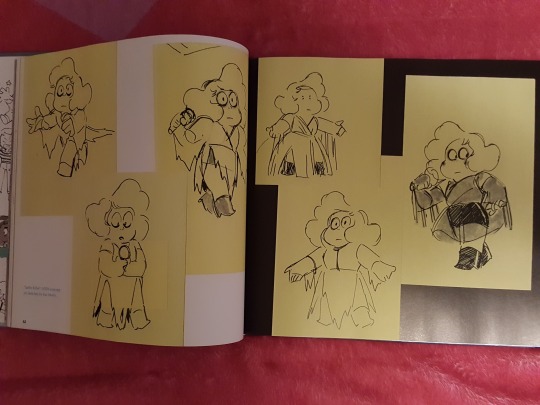
Rebecca Sugar offers some interview bits to discuss writing philosophy and why "writing female characters" was difficult for a nonbinary person who'd been socialized as a girl and a woman. Rebecca has spoken before about how frustrating it is that marketing for cartoons was SO gendered when she was growing up (and to some extent still is).
The Gems in the story are all "she/her," but on their planet they're defined by their work, not by emotion or relationships (unlike women in our society), so having them be socialized opposite to how she was and be able to claim those emotions through choice and NOT as just an expectation "as women" was revolutionary. Rebecca wants her show to tell all marginalized people that they don't deserve to be in the margins.
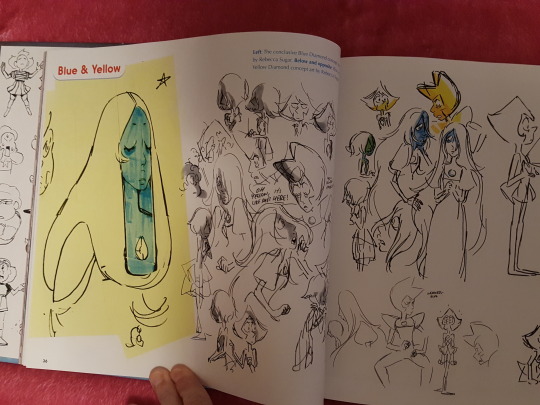
Weighing in on other aspects of the show were Ian Jones-Quartey, Joe Johnston, and Miki Brewster. Ian describes feeling like at first doing SU was a thrill ride that meant they'd finally get to do all the cool stuff, but it quickly became a responsibility that he took very seriously--the need to tell a good story now that he'd been given a megaphone.
Promotional art, planning documents, character sketches, and concept art from the lighthearted to the stone serious is included, along with some very cool (sort of famous) timeline charts that track major characters' developments. It's emphasized by Rebecca that the developmental materials ARE NOT CANON (and especially are not MORE canon) compared the final show.
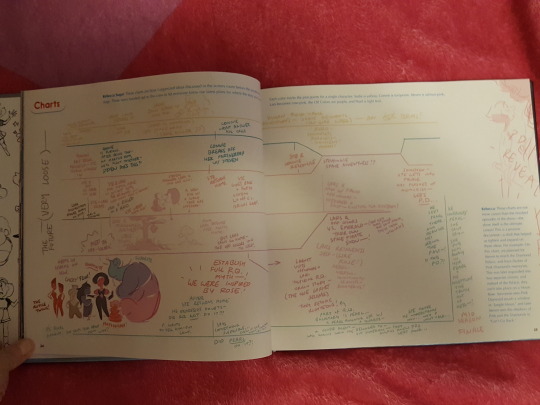
There are concept sketches alongside final art for Aquamarine and Topaz in "Wanted" (with Topaz labeled "Imperial Topaz"), the Zircons in "The Trial," Blue and Yellow Diamond, and the Off Colors (including Pink Lars).
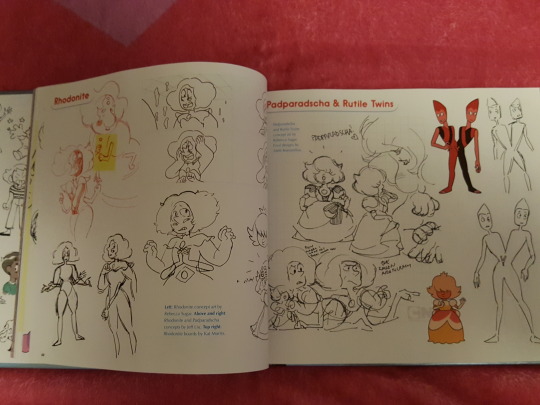
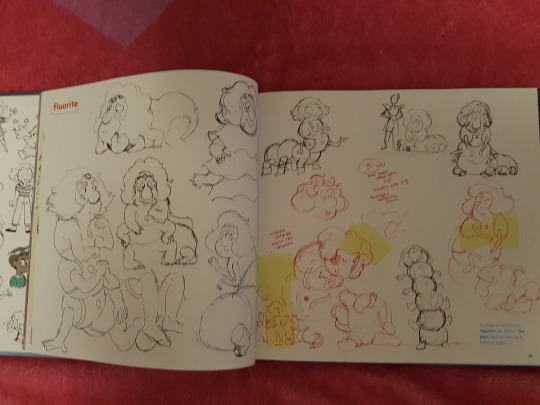
And there's also a spread of "the two sides of Steven's life: Gem Magic and Rock N Roll" featuring Sadie Killer and the Suspects (referred to as "Buck's band")--as well as a cool "Crew Cameos" key and some concepts for short-haired Connie.
And then there's some more "finished" art with stills alongside concepts, including some background art, revision, and really cool "fairytale" art from some of the shadowplay storytelling bits. We get "Lars of the Stars," "Jungle Moon," and "Can't Go Back."
2. THE BEGINNING OF THE END: A SINGLE PALE ROSE

In discussing the huge reveals and Gem mysteries in the show, the pacing is examined, and emphasis is put on the intended "slow burn." One of the most difficult things in the show was to strategize so that every piece that was needed to support another piece in the future was placed properly to seed what it was supposed to.
Some of the ideas they developed were more of a group effort and were fit together collaboratively (like Amethyst's being younger than the other Gems and Jasper being from Earth), while others were intended from the beginning based on Rebecca's vision (the fundamental idea of Pink Diamond's true identity, for instance, as well as Obsidian's design and sword and our Pearl not being Pink's first).
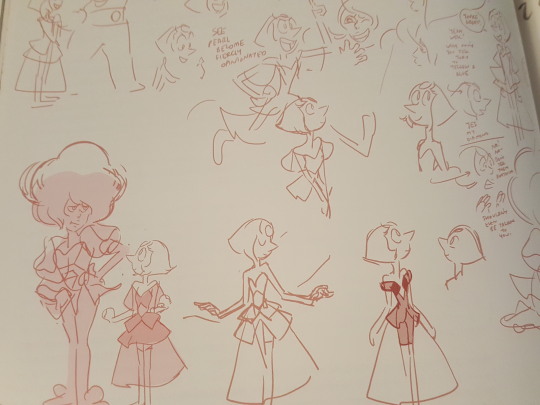
The writing process gets a great deep dive here, including fun tidbits like how the orb in the moon base was inserted by Joe Johnston and they literally had no idea what it was for when they wrote the episode. They repurposed it when they figured out what they needed.
Rebecca credits her detailed timelines for helping keep the order straight, and discusses how other artists are sometimes flabbergasted that a storyboard-driven show can have this much detail and continuity and yet not get wrecked by the free non-scripted boarding process. But Rebecca and the Crew valued that approach and loved the way fresh eyes would handle an idea, making it come back alive, entertaining, vivid.
Several Crew members weigh in on the writing process. Lauren Hecht refers to making lots of incorrect guesses despite being on the inside. Joe Johnston recalled getting briefed on his first day and getting so excited to start working on this massive project.
Miki Brewster remembered being told Rose Quartz is Pink Diamond and being shocked--and also confused about why Ruby and Sapphire would need to be married if they're already basically married. Drew Green talks about being brought in late and getting to watch unaired episodes and a rough of the movie while eating cereal.
Ian Jones-Quartey complains about Pink Diamond's real jester-like form being leaked to the internet through a Hot Topic shirt. Rebecca piggybacks on that and says it was upsetting that the wedding was leaked because of toy fair keychains featuring Ruby and Sapphire in wedding attire. They'd always be worried about leaks, and sometimes Rebecca struggled not to talk about the reality of Pink Diamond before the reveal because she knew it would make so much more sense once the truth was out. And everything associated with Rose makes more sense once you know she's Pink--especially what happened with Bismuth, considering what we know about how Pink Diamond has a habit of treating anyone who no longer serves her interests.
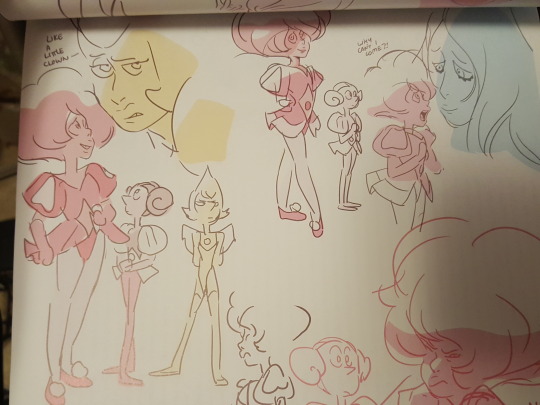
When it comes to visual cues, Rebecca also talks about intentional designs to create a feeling of unity between concepts, like the flower shapes on Pink Diamond's palanquin lining up with the poofs of Steven's hair and the star imagery of the series. Steven Sugar and Mary Nash discuss how the Human Zoo incorporated this imagery, trying to look like Homeworld with a Pink Diamond touch.
Steven Sugar, as a game nerd, liked to throw in video game references from old and modern stuff to feel like he's inserting what he's enjoying and who he is from moment to moment, while Mary Nash, who related to Sadie as a basement-dwelling young person with cult interests, liked to include stuff from MST3K and cult movies. Pearl's hand gestures get a spotlight too--her reflex to cover her mouth when Pink Diamond was being discussed was analyzed here.
A "Top Secret Visual Timeline" from 2016 is included which tells us some Diamond history. It has an earlier version of Pink Pearl's fate and does not include Spinel since the movie hadn't been greenlit. The timeline includes the birth of the Diamonds, the emergence and major story beats for each major character, and some philosophy of the driving force behind each.
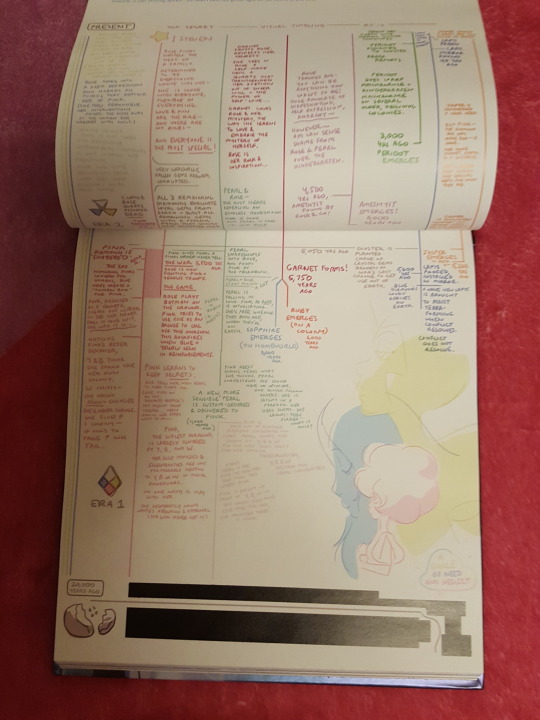
We're told that Pink Diamond straightened up, behavior-wise, after she lost her first Pearl, and that Yellow and Blue wanted to give her a planet but White only agreed to it to prove she would fail at managing a colony. Pearl, meanwhile, is so confused to have a Diamond who keeps asking her what she thinks when she doesn't believe she should have opinions.
And when Pink moonlighted as Rose to start conflict, she found herself leading an army to fight Pink's troops--then Yellow's, and eventually Blue's too. Lapis is said to be waiting for the conflict to end on Earth so she can terraform, but she gets trapped instead.
Pearl's love story with Rose is described as "an endless honeymoon" where she's free to love her, while Rose's is more like "I'm now the head of the family and I'm going to give everyone what they never had, so everyone is super special!"
Jasper is described as "adopted" into Yellow's army as the only successful Beta Quartz. And White Diamond knew that Pink Diamond was not dead--she thought she was just running away from home like a brat and would eventually be back.
3. THE HEART OF THE CRYSTAL GEMS
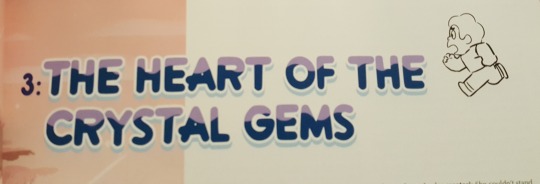
Now we discuss Rose Quartz--the original Pink Diamond. How she was selfish and selfless, never enough and always too much, and how Greg was her first partner who "challenged her" to be an equal. Rebecca describes Rose as being delighted by the idea that both she and Greg reinvented themselves, but when that leads her to want to share her past, Greg isn't interested--he only wants to know who she is now, and doesn't consider the old her to be her.
Rebecca likes Carl Jung's concept of "enantiodromia," which is the idea that extremes lead to their extreme opposite. This is demonstrated in all of the Diamonds. This narrative is interspersed with drawings of Greg and Rose being cute.
But another "heart" of the Crystal Gems is its relationships--particularly, Garnet, the fairy tale romance embodied. More psychological theories are discussed with regard to differentiation in a relationship making the relationship stronger, and how they made sure that happened for Garnet during the appropriate arc. Rebecca has struggled with the idea that she, like Ruby, went straight from a "family" group to a living-with-others situation and never lived by herself. But she also learned that you can in fact develop as a person in the context of a relationship--you don't have to be alone to do it. Ruby learned that too, and chose on her own terms to be with Sapphire.

The wedding made so much sense to Rebecca and the crew that they couldn't imagine a wholesome couple like Ruby and Sapphire not having a wedding episode. They wanted it for years: The wedding concepts always included the tuxedo for Sapphire and the wedding dress for Ruby.
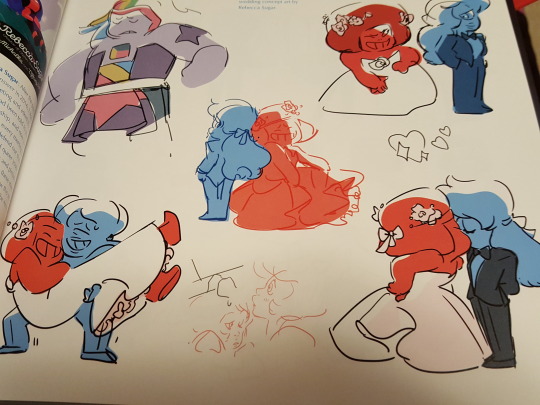
But pushback (often blamed on the conservative standards of the international market) led to negotiations trying to keep Ruby and Sapphire's relationship from being explicit. Rebecca and the Crew were very tired of this double standard, and they were especially irritated by attempts to claim a wedding wouldn't be well received by a core demographic or wouldn't make sense for Steven's character. But other shows had done weddings and Steven had been established to love weddings already.
Rebecca kept adding more elements to the wedding episode to answer all the concerns, but she didn't want to back down from explicit marriage between these characters. They deserved it. And the audience deserved to see this as wholesome, like any other cartoon wedding. Eventually they got their way and were allowed to have the wedding. But the ordered episodes were also coming to a close without promise of more, so Rebecca had to request more episodes to be able to wrap up the storyline!
And of course, there is Steven, the true heart of the team. A very interesting aside discusses Garnet's leadership and how the network pushed the Crewniverse to acknowledge Steven as the leader. This was successfully resisted throughout as well--because Garnet is the leader (unless she's incapacitated, of course). It's fantastic that this concept was preserved because too often a young male chosen one is elevated above people with more experience and knowledge because of that chosen one tradition, so it's really nice to have a show acknowledge that team leadership is more appropriate for an adult.
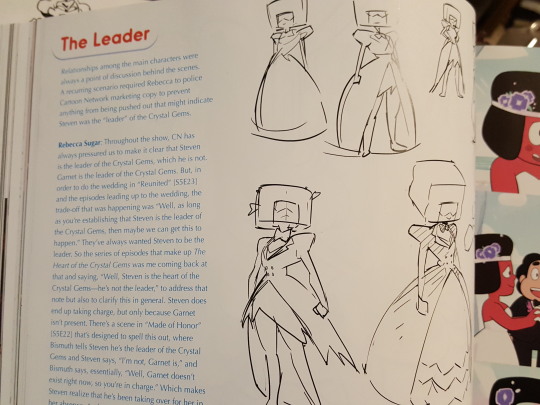
4. ERA 3
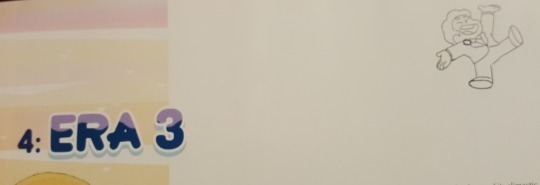
Beginning with a discussion of the Diamonds, this chapter deconstructs the dysfunctional "family" of the Diamonds (who are said to be based on tropes about evil stepmothers and stepsisters), with the thread of dysfunction originating with White Diamond.
Yellow is physical, Blue is emotional, White is judgmental, and Pink is impulsive. Some philosophy on why Pink is naturally manipulative and why she clashes so much with White is offered.
White believes her identity is to be imposed on all because she is the pinnacle of what should be--and therefore, she has the right to make decisions and statements about and on behalf of everyone. But her secret is that she can't do what the others do--act or feel or want. In trying to be everyone, she is no one.
And this becomes very important when she confronts Steven about his identity and turns out to be wrong. The triumph of Steven being totally, fully himself is a beautiful, simple revelation that's described as far more satisfying than the theories about Pink living inside him or Rose returning from his Gem.
Also discussed is Gem architecture. A lot went into this idea, and Steven Sugar weighs in to say he had to think of what it would mean for a world to have buildings but serve no human needs. That's why it's mostly focused on transport and storage. Even the broken planet is meant to indicate a place stripped for its resources, and everything serves a function that is meant to avoid looking like the human equivalents.
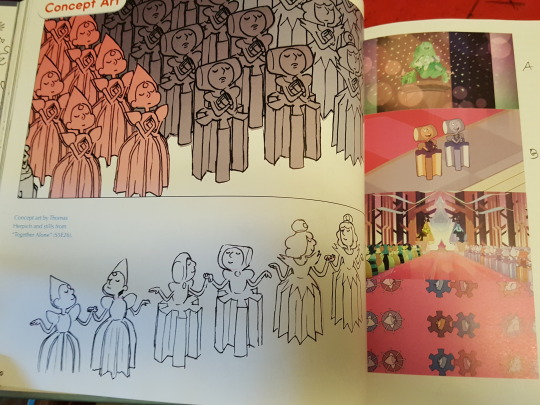

And there's another layer, too: a difference between Era 1 and Era 2. Era 2 became more functional to hide Era 1's broken bits, and older Homeworld buildings still have some "ornate and ancient" feel to them. And the fact that props, tools, and even walls and doors could be living was taken from a concept Rebecca thought was horrible from old Busby Berkeley movies, where people were inanimate objects and it was portrayed as lovely. Tom Herpich helped conceptualize these living objects.
Steven dealing with "princess tropes" is discussed here too. The Pebbles (worked on with Pendleton Ward) were sort of his Cinderella's mice, and all the locked-in-a-tower, having supportive tiny friends help you, getting princess clothes made, attending a ball, having to mind your manners stuff was intentionally related to fairy tales.
The point of doing that (besides fun) was to easily invoke the feeling that Steven was being made to be someone he's not, and that he was being treated like THIS is who he really is when it isn't. White Diamond as the "evil stepmother" is discussed with regard to her detailed features and massive scale. They generally didn't put fingernails and eyelashes on characters (especially not to indicate that they were women or girls!), but they decided White would get all of these feminine markers for tradition's sake.
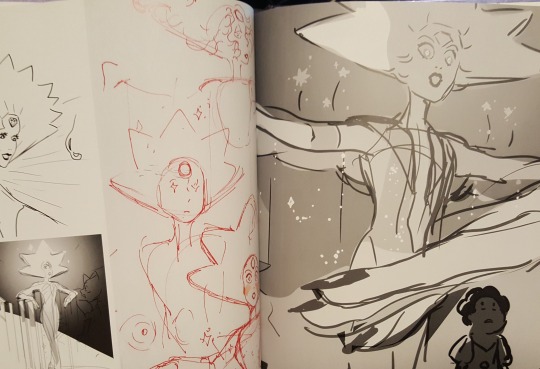
Rebecca also invokes several other references that were included and describes the princess tropes as "chipping away at his integrity" setting him up for the final challenge with White.
There is again tons of concept art: Homeworld architecture, Pebbles, Diamond diagrams, background Jades and Lemon Jade Fusion, Comby, Diamond extraction chambers, and White Diamond.
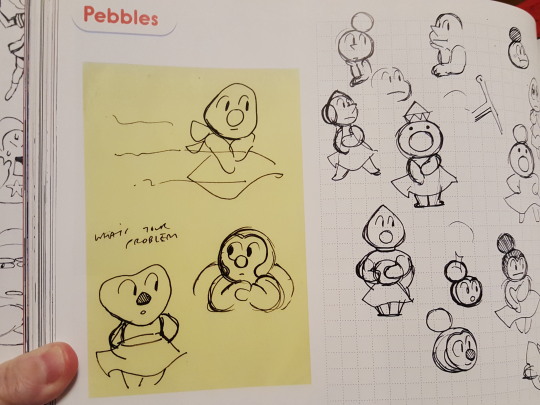
5. CHANGE YOUR MIND

Now we finally begin to discuss Steven's identity. The "Perfect Steven," discussed in several interviews before this book's release, was an idea back in 2013; the "ultimate Steven," beefed up and shonen-looking, was far from perfect because OUR Steven is perfect, while this alpha hero Steven idea (used in Steven Universe Future) didn't belong being idolized in such a show.
They thought about having Steven fall apart into organic half and Gem half early in the show (during "Giant Woman" after a successful fusion and unfusion, even!), but they didn't try the concept until the last episode. They didn't want the "Pink" Steven to be portrayed as "better" even though he would be more powerful, so they decided he isn't whole without his organic self and he's just as much of a shell as the organic half. They absolutely did not want any ending that required Rose to be inside him or waiting to come back. But the debates were fierce--what DOES it mean to have Rose's Gem?
Ian Jones-Quartey brings in an anecdote about his own family to emphasize some of the immigrant themes that inspired aspects of the show. He had a brother who reinvented himself elsewhere away from family without resolving issues, and all the ramifications of that were explored in the show through Rose Quartz. (He is careful to say he doesn't think his immigrant experience is like being from another planet!) But he did say you can hurt your old family even if they were toxic or didn't know the real you, and you can hurt your new family by hiding your past. The Pizza family of course was also a more direct reference to Ian's Ghanaian family.
In talking about the new Fusions from this episode, Sunstone is largely described by Miki, who also got to board the Sunstone section. Sunstone was described as a cool 1990s character and the evolution just continued into making them a fourth-wall-breaking PSA dispenser. Obsidian is also discussed, with their sword being an early concept. Steven Sugar said they totally knew it would be forged in action. Obsidian being similar to the Temple design is of course another very early detail.
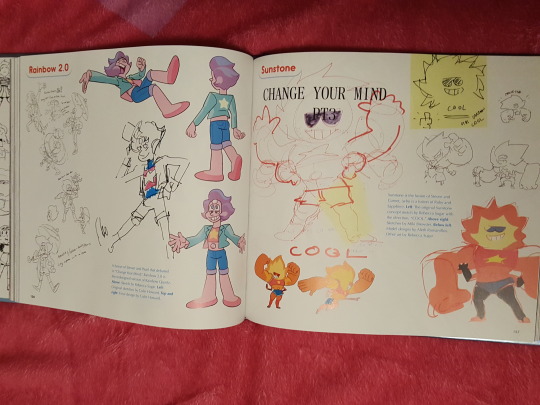
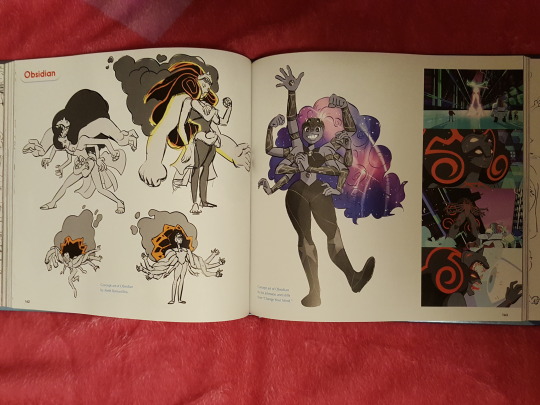
The story of how James Baxter got involved with one of the final scenes (Organic Steven and Pink Steven fusing in front of White Diamond) was shared. His family was fans of the show and Rebecca Sugar took the time to drive to a birthday party for his daughter and give her a drawing. He then owed her a favor, and this was it.
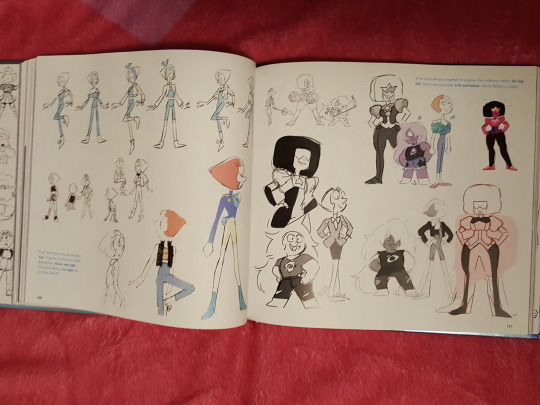
Concept art is again included, this time with sample boards, promo images, a Diamond fight concept, costume design changes for the Gems, new Fusions, the so-called "Mega Diamond" ship conglomerate, some scenes from the White Diamond confrontation, Pink Steven, multiple pages of James Baxter animation, corrupted Gems and their healed selves, and photos from the "Change Your Mind" premiere and some awards. The show has won one design-related Emmy, a Peabody Award, and a GLAAD award.
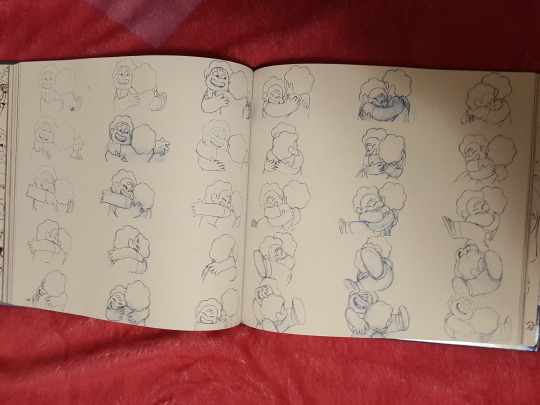
6. STEVEN UNIVERSE FUTURE
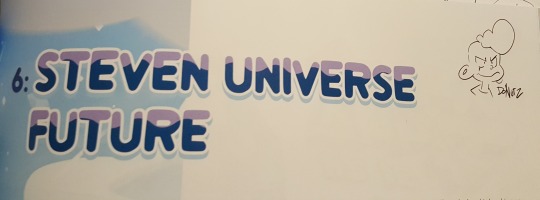
The book doesn't cover the movie because it got its own book, but dives right into Future. Ian Jones-Quartey emphasizes that the movie and Future are separate and different from the original show, which ENDED. After all, after that, Steven has a neck!
Some new names are invoked now: new writers Kate Tsang, Jack Pendarvis, and Taneka Stotts. They were excited to have Steven make HIS OWN mistakes instead of trying to clean up someone else's! Now, instead of doing the usual shonen anime thing and having the final battle be a big physical rumble, Steven has to make peace with himself and take an active role in coping with what all the fighting has done to him and what effect it's had on who he is (and who he wants to be). There is no sudden "I love myself!" answer, either. It's always a process.
Drew Green and Maya Petersen, who came on board as storyboarders officially in Future, also weighed in on writing for a "mature" show, how to deal with Steven being a "moral compass" while being sort of unreliable, and what they learned as Crew that they didn't know as fans. Drew didn't know Garnet never asks questions. Jack didn't realize the show never deviated from Steven's point of view. Taneka was nervous but excited to collaborate. Kate was worried about how established the show was and what to do as a new writer to contribute appropriately.
Maya was on the old Crew but not as a storyboarder, so felt like some of the "old" ideas ended up not being appropriate for the "new" Future in an embarrassing way--and dreaded the idea of dealing with Steven's emotional problems when they were similar to stuff she'd been through. She also was personally behind the idea of Steven wanting to dump his problems by becoming Stevonnie, and got to work with Etienne Guignard on inventing the Pearl creation backstory with Volleyball.
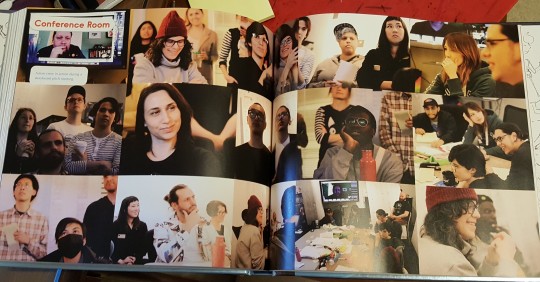
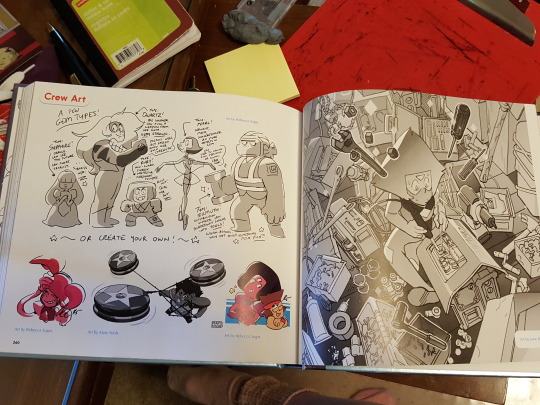
There's some discussion of "depression hobbies," stress, and the show's pacing. And they say Etienne was entertaining at pitches. There's even some discussion of how Greg is taken off a bit of a pedestal because his terrible restrictive life in the suburbs sounded wholesome to Steven and Greg presented it negatively.
And then there is some information about how the Crew felt behind the scenes due to fan reactions and negative press. Ian discusses feeling offended when the Black characters are described as bad examples, as if their cartoonized but realistic-in-context features are automatically caricatures.
Rebecca Sugar felt beaten down by some of these narratives and began to access mental health services, inspiring some of the content of "Mindful Education." A long reflection from Rebecca discusses people's infighting about her show and what she had a responsibility to show or not show in the story. She learned a lot about bullying from Cartoon Network's anti-bullying program and learned that bullies thrive on whatever attention you give them--unless it is made clear to them by a peer group that no one is impressed by their cruel actions. Also, not all negative feedback is bullying. Constructive criticism is different. Self-awareness can help you avoid internalizing what bullies might do or say to you.
Segueing from the discussion of how people are affected by and connect with the show, we then discuss how they chose as a team what should be covered as the show came to a close. They didn't have time to do quite a few stories they wanted time for, like a Rhodonite story, a Lars side story, and Diamond "prehistory" and religion; all of it was put aside for the main arc with Steven.
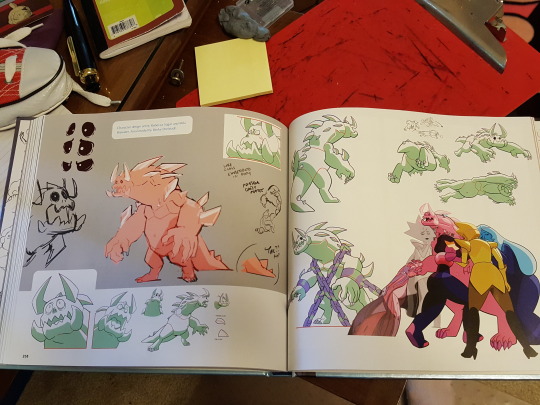
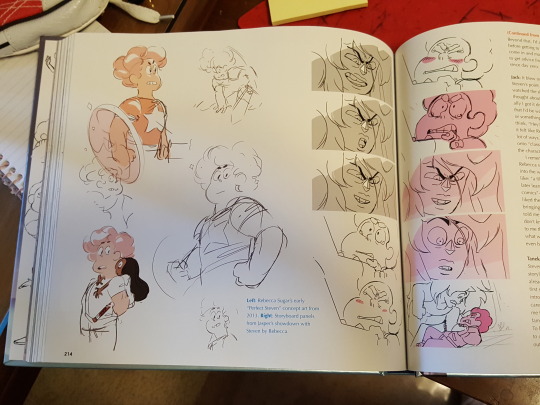
They thought people would find those stories about Homeworld and Off Color history very interesting, but so much of the show had been about Steven's Gem adventures, so keeping him mostly on Earth seemed appropriate. The acknowledgment of his battle damage, of his trauma, was necessary and real, and helpful in an important way to the core audience.
Oh, and there was some stuff about a cheeseburger tree. Don't ask.
In discussing the "reverse escapism" of the original show (Gem aliens are intrigued by everyday human culture, and realism is necessary), Rebecca says her views have changed on escapism and gets why some people want a soothing feel-better show. She acknowledged also that her own escapist dreams-come-true fulfilled in the show didn't feel like escapism because they were givens to the majority of mainstream culture, but were never guaranteed to marginalized people.
Rebecca ties in her several-times-told story about "Love Like You" and how the middle bit was when she didn't feel she was worth looking up to, and the realizations she had to tie the beginning to the end. Feeling like someone will like you less if they know you more is terrible. So sometimes a show like this can be helpful in telling people that they belong when their fantasies are things like "I want to be loved" and "I want to know I exist."
In Future, Steven has to connect to who he is and love that person--and understand that person enough to finally feel that even if he's not fixing their problems or saving their world right this second, Steven deserves his family's love and support, and they WANT to give it to him.
There's a huge amount of supplemental material in this section so there's no way I could name it all. The charts for Future's timeline are pretty straightforward, though a few episodes like "A Very Special Episode," "Why So Blue," "In Dreams," and "Bismuth Casual" aren't specifically represented and a couple are in a different order ("Prickly Pair" was conceived as happening after "Fragments" and "Homeworld Bound").
Steven feeling like a monster, having intrusive thoughts, having not forgiven the Diamonds, and getting help/moving on--it's all there.

We have keys, color scripts, and boards for the new opening and some various backgrounds and storyboard art from episodes. Model sheets for Shep, Nice Lapis and Mean Lapis, Jasper, Steven Tag Gems, Pink Steven Powers, Monster Steven. New house concepts, Era 3 Homeworld concept art for the Diamond environments, and background art for the Reef.
New Connie and Greg designs. Concepts for Mega Pearl, the Rose Quartzes, Bluebird, and Morganite (who didn't get used). And there are some photos from recording and the conference room. There are even some extras from "Crossover Nexus," the crossover with OK K.O.!--including an unused cut scene that included Ruby and Sapphire fighting. The rest of the book is a bunch of adorable Crewniverse art--extras, blog drawings, promos, and gifts to each other.
NOTABLE
1.
The first timeline chart in the book features a cool sketch of the original Off Colors, which at the time this planning document was drafted included unused Off Colors Flint and Chert.
We knew of their existence already because of an episode of the podcast, but these two unexpectedly appeared as incidental characters in the Steven Universe Future episode "Homeworld Bound," identified only in the credits. Sad to think that instead of banding with the Off Colors, these two were probably shattered for their crime (being Quartzes who don't want to fight) and that's why we see them being repaired in this episode. Later, there's some brainstorming for types of Off Colors and "a Ruby that wants to wear limb enhancers" is mentioned as well.
2.
It looks like there was also originally more juice to the story of tracking down the events of the war culminating in Pink Diamond's assassination.
One of the timelines talks about Steven thinking it makes sense that Pearl can't talk about her involvement because she might have been a double agent, explaining why Rose Quartz always knew what Pink Diamond was doing. It seems like that bit was supposed to be included in Garnet's version of the story she believed in "Your Mother and Mine." Seems like they originally conceived Garnet's story to inspire the Off Colors to become pirates and freedom fighters, though in the show's canon this storytelling happened after Lars had already reinvented himself the way he did.
Sadie was also supposed to be sending letters to Lars via Steven, which is funny since the "Letters to Lars" episode is just a montage Steven letter. And of course it's specified that Steven was supposed to get Pink Diamond flashbacks by going to the Palace on Homeworld.
3.
The second chart in the book makes references to Sadie's reinvention of herself as a parallel to Lars, Greg, and Pink Diamond all doing the same thing, and how positive it is to embrace such a thing--a version of yourself that YOU create.
I love that Yellow Diamond's arm ship arm-wrestling the Cluster was always part of the plan.
There's some more explicit direction to have Connie help Steven understand the Diamonds as "strict parents," and a lot more emphasis on everyone realizing Rose had been inspired by THEM rather than them all following her.
White Diamond is presented here as if she thinks of Pink Diamond as a "daughter" (whom she now understands she has "lost"). There are notes on how the Diamonds have a responsibility to their children and should attend to it before just continuing to make more.
4.
One of the concept art images for the Off Colors features Rhodonite crouching by Padparadscha saying "Don't worry, I won't let them hurt you." It's very interesting because she DOES seem to protect Padparadscha in the show, but doesn't seem confident about it in her final version, even though it does seem like she'd be "programmed" to guard aristocratic Gems because of her Ruby and Pearl makeup. Cool.
5.
A "Crew Cameos" spread was included, which is of great interest to some of us who loved seeing the Crew insert themselves into the show. Not every SU Crew person who's been represented in a crowd was there, but this crowd included Amish Kumar, Kat Morris, Amanda Winterstein, Angie Wang, Lamar Abrams, Emily Walus, Mary Nash, Joe Johnston, Christy Cohen, Danny Cragg, Hilary Florido, Danny Hynes, Matt Burnett, Ben Levin, Elle Michalka.
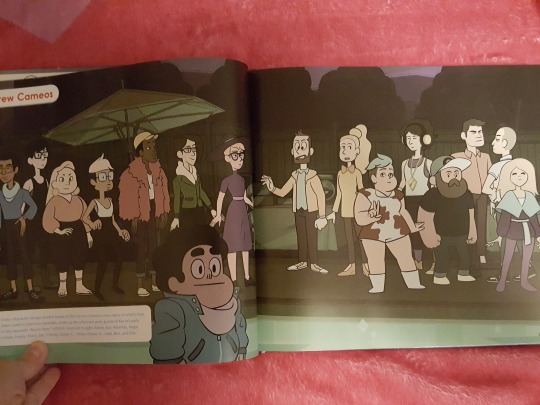
6.
The official national flower of South Korea, Hibiscus syriacus, is the name of Pink Diamond's flower.
7.
One of Steven Sugar's comments about the silhouette difference between humans and Gems points out that humans have ears. This seems to be pretty good confirmation that they are not supposed to have ears, despite that sometimes we'll see ears drawn on them in some frames.
8.
Rose Quartz/Pink Diamond is characterized in this book as "self-hating" in a really interesting way, saying that because she believed she was not capable of compassion, she practically worshiped those who demonstrated that ability and thought they were so much better than her--which is described as "intoxicating" and resulted in others being drawn to her. How interesting is that!
9.
Timelines reveal that early plans for Pink Diamond's first Pearl originally had her getting destroyed by Pink during a game, and then her destruction was rewritten as a punishment from the Diamonds after Pink Pearl defended Pink Diamond to the other Diamonds. They went back to the idea of her getting hurt by Pink for the final version, though the cracked face and control by White Diamond was not on the agenda until they started writing "Change Your Mind."
10.
The approximate ages of the major characters, based on emergence, are revealed on these timelines. It begins with a cracked-planet-looking graphic depicting four tiny Diamonds emerging at 20,000 years ago. Some suspicious "blacked out" redacting surrounds a long timeline tail that goes back before that, which may mean there are secrets they still don't want to reveal. But the dates go like this:
20,000 years ago: The Diamonds emerge.
11,000 years ago: Pearl is custom-made for Pink Diamond.
8,000 years ago: Sapphire emerges (on Homeworld).
6,000 years ago: Ruby emerges (on a colony).
5,750 years ago: Garnet is formed.
5,600 years ago: Lapis is poofed and put in the mirror.
5,200 years ago: Jasper emerges (on Earth).
5,050 years ago: The Cluster is planted.
5,000 years ago: Amethyst emerges (on Earth).
4,500 years ago: The Crystal Gems found Amethyst.
3,000 years ago: Peridot emerges (on Homeworld).
40 years ago: Pearl found Lapis's mirror at the Galaxy Warp.
And of course we know 14 years ago Steven is born!
11.
Originally the Diamonds were based on a quartet of themes: Love, Fear, Pride, and Sorrow. It got too complicated to keep and it was abandoned, with Pink's identification of "love" being described as "particularly outdated."
12.
Notes on a sketch say that Pearl was inspired to become bold and unashamed because Pink's questions drove her to have opinions, and it's said that Rose "fell in love" with her boldness.
13.
Rebecca tells the story of driving off a ridge and getting stuck in the desert, comparing this to Ruby's tumble during her Wild West adventure and using it as inspiration. She's told this story before but here it is in print. She also included the story about using the flowers from a friend's wedding to put in Ruby's hair.
14.
Rebecca describes having to "fight" notes she was given when it had to do with Ruby and Sapphire's relationship. One she describes as NOT fighting was for a signing card depicting Ruby and Sapphire dancing. It was called "too romantic" and she decided not to worry about it since it wasn't the actual show content.
She was also scolded over her book The Answer because the powers that be expected her to downplay that relationship. She always argued that queer youth deserved these things.
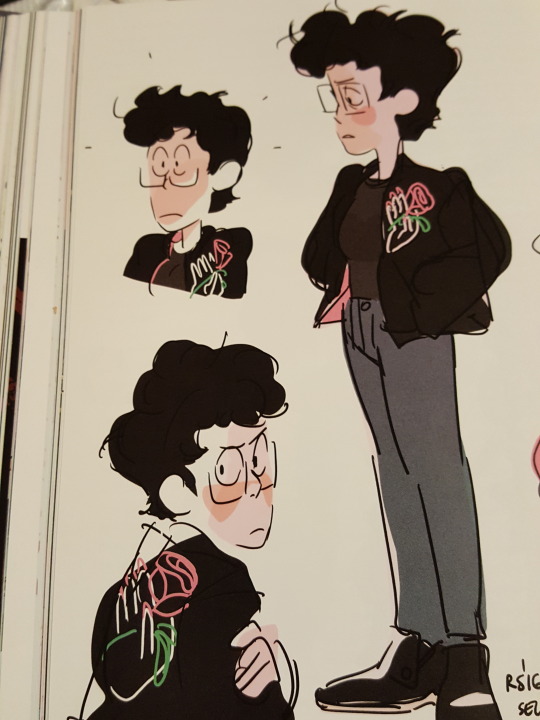
15.
Tom Herpich describes being inspired to name Blue Diamond's comb "Comby" because he was watching the news about Comey getting fired from the FBI. It's also a mineral-related term and I always assumed that reference was intentional, but maybe it's not and this is the only intended significance to Comby's name?
16.
Rainbow Quartz 2.0's design is not discussed, though the other two new Fusions from "Change Your Mind" (Sunstone and Obsidian) were. RQ2 has some sketches included, but no accompanying narrative in the text.
17.
A sheet of corrupted Gems and their healed selves is offered, though it doesn't appear to be final. The obelisk in "Serious Steven" is labeled Albite. The unnamed Worm Monster, Desert Glass, and Watermelon Tourmaline are included. An unnamed birdlike Gem represents the Big Bird monster from "Giant Woman." The crab monster from "Arcade Mania" is labeled Blue Chalcedony. The Tongue Monster is drawn uncorrupted but not named. The Flower Monster from "Back to the Kindergarten" is labeled Grossular Diopside or Titanite. The invisible monster from "Island Adventure" is labeled Moonstone. The Lighthouse Gem is labeled White Topaz. A form for Larimar that was used in "Change Your Mind" but changed in Future is there. The Slinker is listed as Chrysocolla. And the Crab Monster is listed as Aventurine.
On the next page, this is changed to Bixbite (as it was in Steven Universe Future), and we then also have Lace Amethyst, Blue Lace Agate, Crazy Lace Agate (Fusion), Ocean Jasper, the Mother Centipeetle Nephrite (Facet 413 Cabochon 12) and three other Nephrites, Angel Aura Quartz, a hooded Jasper, Zebra Jasper, Biggs Jasper, Watermelon Tourmaline (labeled as Fusion of Gem * Onion--huh?), Snowflake Obsidian, "Little" Larimar, and Orange Spodumene (who was the Worm).
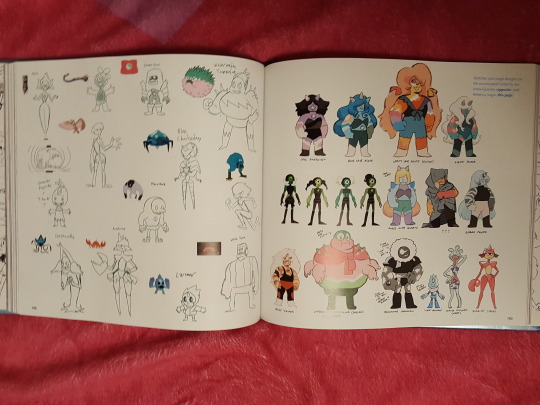
18.
The Rhodonite side story would have been about the love story of a Ruby and a Pearl working for Morganite. Images of Morganite and her servants, unfused, are in the book. We do not get this additional information, but Rebecca said in a panel shortly before the book's release that Rhodonite's story would have been about finding out that she had been Rejuvenated 17 times because her components kept falling in love and needing to be reset.
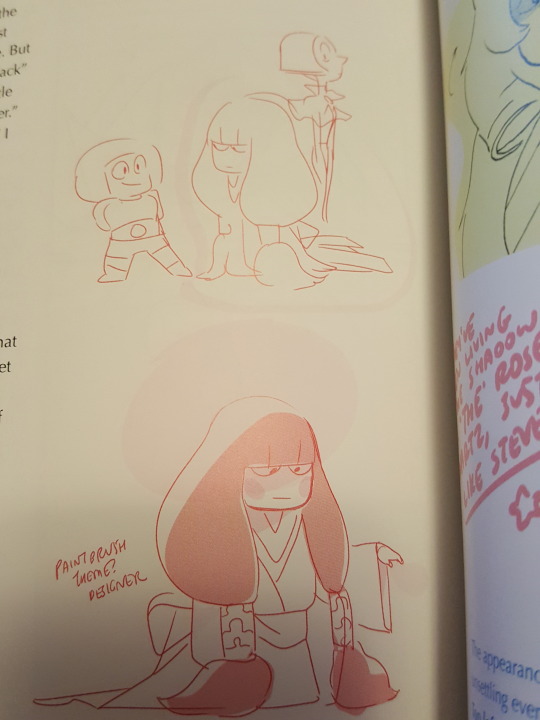
19.
Referring to the Diamonds on one of the charts, Steven's perspective is "I can't believe I helped these" and then there's a censor bar. Welp.
20.
Some included art by Hilary Florido features Kevin with a souped-up Koala Princess car and another where Kevin is staring at himself in the mirror in front of an altar to himself.
21.
Rebecca's sweater collection is included in the Crew art.
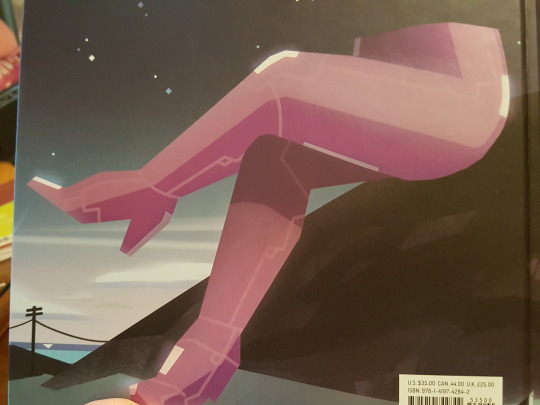
[SU Book and Comic Reviews]
159 notes
·
View notes
Text
Progress Update 7/23/21
Happy weekend! Hope everyone is doing well.
A quick welcome to all of the new followers! I got quite a few this week, so I want to take a moment to thank you for following! Every single follow I get is its own type of support, and it truly means a lot to me. Don’t ever be afraid to hit up the ask box for questions about my WIPs or concerns about my writing or things I say on this blog.
Now, let’s get down to the business of the progress updates, below the cut!
Ninelives
I’ve gotten a lot of work done on both the Twine and CS versions of the game.
Starting with the CS version, I’m almost to the theoretical halfway point of Chapter 6. I say theoretical because, in terms of the amount of writing I have to do, it’s not technically halfway at all. But, in terms of what readers will experience, it will be the halfway point. The total word count is up to about 13.5k words. In terms of playthrough wordcount, I haven’t done the testing for the numbers yet, but I will have those numbers when I update the demo at the end of the month.
I frequently redo my outlines before I start writing to make sure I’m accounting for new information or anything that I forgot in previous outlines. I thought it would be fun to share a very basic breakdown outline with you all so that you can see what Chapter 6 will look like. I blacked out the only majorly spoilery bits.

Parts 1 and 2 of Chapter 6 are already written, so they are not listed here. You’re looking at the remaining portions. I’m currently partway through #3. I made some adjustments from my first outline, where Alex used to be an option in part 5. A lot of the items marked with the # symbol are just personal reminders for tone and smaller variations within the text that need to happen. It’s more like a checklist than a breakdown, and it helps me keep focused on the overall goals of the chapter.
I got about 5k words written into the Twine version this week as well, which is pretty significant considering most of what I wrote there was new content that is not in the CS version of the game.
That new content involves deciding how the PC and Alex met each other. There are three choices, and they vary between both the physical location where they met and the age that MC was when it happened. This means that, with these new choices, MC might have known Alex before the drowning incident or not, and there will be appropriate variations later in the story based on whether they were friends when that happened.
I still have one more branch of that new content to write before the scene returns to something more familiar and my focus turns back to revision.
Also just for fun, here’s a visualization of the story map in Twine as it stands right now.

Everlight
I haven’t gotten very much work done on Everlight this week since I’ve been really pushing to get Chapter 6 of Ninelives to the halfway point, so I will not be dropping the Chapter 1 demo for this project at the end of the month as I had hoped.
I have, as you may have already seen, started dropping some lore posts about it to give people a better idea of the Everlight setting. There will be more posts in the future, some of which will include more information about the ROs as well.
As always, I hope everyone has a happy and healthy weekend, and thank you for your continued support!
25 notes
·
View notes
Note
Storytelling asks 12, 13 and 14 ❤️
𝐒𝐓𝐎𝐑𝐘𝐓𝐄𝐋𝐋𝐈𝐍𝐆 𝐀𝐒𝐊𝐒 / accepting !
these were fantastic questions !! thank you !! ❤️❤️❤️
12. do you actually play the game or do you just use it as a storytelling medium?
lately, it’s been 100% storytelling, but i am so eager to actually play the game soon. i’ve been working on my historical legacy for ........ geez, like five years or so? i guess it began as my bastard version of the decades challenge, lmao. anyway, long story short, i haven’t finished it, and i need to so i can replay the parts i miss. additionally, my plan is to finally get the cottage one when i finish part ii of the story !!!!!!! and do some legacy gameplay (haven’t decided if it’ll be canon yet but it will, as i’ve said, be jered circa 2007).
13. from basic planning to a finished post, how long does that take you?
OOF. it varies? here are the steps u didn’t ask for
get an idea, scribble some notes in my journal or on scraps of paper i then stuff into the journal. draw diagrams as needed.
scour the internet for poses (detour to make my own sometimes)
build a set (this is what i do 65% of the time. sometimes it takes half an hour, sometimes it takes a few hours. depends on if i need to download cc, build an exterior, spend 45 minutes arranging deco items NO ONE WILL SEE ssdjflksgfs)
occasionally, a detour to recolor / convert objects (not often but often enough that i know how to do these things now djfshgkjsg)
dress up my sims !!! make sure they have different versions with accessories as needed, etc. (ex. for the bachelor party, alf & his friends each had six outfits. nightmare.)
take screenshots !!!!! i do this... based on the mental script in my head. so 60% “i know what happens,” and 40% “vibes only.” takes longer if i have to mess around with lighting (using reshade and/or by ... breaking everyone’s poses to adjust the light fixtures. usually for night scenes.)
pick max of 10 screenshots from the 1287398494 i took. i just upload them to photoshop & click around until i’ve got the best of the bunch. sometimes i post the rejects as previews or outtakes.
upload screenshots to tumblr drafts & let them marinate.....
add captions !!!! i’ve started writing them in photoshop, aka the most cursed approach. i just revise & rearrange until it reads well & hits all the marks i had in mind for the scene. i’m WORDY so seeing the text on the image helps them ... not be giving a monologue in every episode. just most. then, replace drafted shots w/ captions screenshots.
potentially, after marinating, i decided i hate the screenshots & redo them !!!!!!!!! not all the time, but maybe 3-4/10 times.
write the scene. this varies wildly bc sometimes i slap two sentences & call it a day, but other times i pull out my writing laptop & pour over it for ... anywhere from a week to twenty minutes.
ideally, the draft marinates again, then i queue it at least 10 minutes before midnight
SO ........ overall, i would say this process can take anywhere between 2-3 hours to a few days. the longest i’ll have an average draft waiting is a week ??
14. do you have any regrets about your story so far? if you could go back in time, how would you fix these?
my number one regret is ... not realizing how invested in this hobby i would be, so therefore not bothering to properly plan things !!! winging it was fun and easy, but now i’ve learned so much—from both trial and error & the amazing storytellers i’ve met. still, rather than going back in time, i’m excited to apply all of this to the upcoming parts. hopefully the story will be much tighter, richer, and visually pleasing as a result !!!! also. wish i’d known about the tool mod sooner ......... sigh. lastly, i wish i’d learned how to make my own cc any of the previous times over the years i’ve attempted it. sure would come in handy, what with all the period specific fashion i want >:^( maybe next time.
11 notes
·
View notes
Text
“Her Sweet Kiss” - A Short Analysis
Preface: In my job, a key part of my role is to select and analyse various different forms of poetry (yes, lyrics are a type of poem) so, I am keenly aware of the difference between what could be considered quality poetic verse and the doggerel we frequently hear passed off as lyrics in modern songs. I was expecting the latter from the soundtrack to Netflix’s The Witcher, I was wrong.
Although, at first listen “Her Sweet Kiss” appeared to be a simple love ballad, the uncommon depth and intricacy of the symbolism stunned and forced me to take another listen. Additionally, its arrangement within key scenes of the episode, as well as the inclusion of both alternative lyrics and instrumental versions was ingenious. I don’t have time to do a full analysis, instead, I have pulled together a basic overview of the key elements which stood out to me from this marvellously complex song. I hope this may assist you with your own interpretations.
Before we start analysing the lyrics, let’s look at the contextual placement of this song within the episode 'Rare Species'. It is featured at three key moments; the opening scene showing Jaskier composing the song, the sex scene between Geralt and Yennifer and then finally played over the credits.
In the opening scene, Jaskier is shown singing and composing while waiting for Geralt to return from a hunt. The lyrics are slightly different here and include the adjectives ‘gorgeous’ and ‘lovely’ in reference to the ‘Garroter’ character. He asks the men nearby whether the metaphorical use of ‘garroter’ is too ‘cerebral’, indicating that it is indeed symbolic of someone (Geralt). The lines “I’m weak, my love, and I am wanting… Gorgeous Garroter, jury and judge”, are sung by Jaskier and introduce the concept that the narrator is in love with someone but is also conflicted about their choice to follow them on 'The Path' (more on this later). It is also important to note that the notebook resting on his thigh contains an alternative version of the lyrics which do not feature the secondary 'her' character yet and instead focus instead on the narrator’s own weakness and inability to leave what he feels in an unfair relationship 'If I were a man of more merit, if I were a man of resolve I’d leave you behind, get my fair peace of mind'.
The second time the song is heard during the sex scene between Geralt and Yennifer. This time the song is purely instrumental. The moment where they first kiss, the chorus line 'She’ll destroy with her sweet kiss' is playing. As the audience had already heard some of the song, they would recognize it. But as they only heard the earlier version, which describes only the narrator’s willingness to suffer to be with the one he loves, the full significance of the song is not yet established with the audience. This lack of audible lyrics further symbolizes the narrator’s uncertain feelings towards their relationship at this point in the episode. But also unambiguously associates the song with both Geralt and Yennefer, establishing it as a proxy theme song for their romance and further supporting the argument that the characters from the song are indeed Geralt and Yennifer.
The final time this song is heard is over the end credits, this time the song is sung by Jaskier and plays in full. The previous ambiguity is sharply contrasted here when the revised set of lyrics are presented to the audience and the true theme of the is song revealed (Jaskier’s anguish). The final scene between Geralt, Yennifer and Jaskier is key to contextualizing these lyrics as it directly foreshadows many lines and themes explored in the song. For example, in Jaskier’s line 'that’s not fair' echoing the lyrics directly and the show’s constant depiction of Yennefer using storm imagery (both themes explored in more detail below).
The Characters
The song contains three distinct characters 'I/Narrator', 'You/Garrotter' and 'Her'.
'I/Narrator' – The narrator of the song, possibly Jaskier – It has been established in songs such as ‘Toss a Coin to Your Witcher’ that Jaskier frequently writes from his own perspective and as clearly illustrated in the lines 'When a humble Bard, graced a ride along with Geralt of Rivia along came this song' frequently portray Geralt as their protagonist (this is also canonical for the books, but, I’m limiting my interpretations to the show). Additionally, many key themes and concepts from the lyrics directly reference Jaskier’s own life and experiences (explored in more detail in later paragraphs). It is later shown that Jaskier has written so many highly successful songs about Geralt that the prostitute in the opening scene of ‘Betrayer Moon’ was able to identify his scars by their relevant songs and was surprised to find one that she did not recognize. It can plausibly be argued that ‘Her Sweet Kiss’ is both autobiographical and includes Geralt as a key character.
'You/Garotter' - The love interest of the narrator and also addressed as 'My Love' and 'Fool' - We can connect this 'Garotter' character with ‘Geralt’ through both the phonological similarity between the words and in scene featuring Marilka in the episode 'The End’s Beginning' when she points out 'Geralt'… like Garroter?' a canonically explicit linking of the names. ‘Garotter’ is a term for a killer, specifically, someone who does so through strangling, symbolic of Geralt’s employment. Jaskier himself points out that the ‘metaphor’ may be to ‘cerebral’, indicating to us the audience the need to interpret the line figuratively rather than literally.
'Her'- The rival for the narrators love interest - A woman described as a destructive and unjust force, using wild, nature-based metaphors such as ‘storms’ and ‘currents’ to describe her ‘love’. Repeatedly throughout the show Yennefer is also described using similar nature/storm imagery, such as Geralt’s description of her 'like a tornado wreaking havoc' (a line Jaskier is shown to have overheard as the camera pans to him).
The evidence then supports the supposition that the song may well be written from Jaskier’s perspective, exploring his feeling regarding Geralt’s and Yennifer’s relationship (for a discussion on the dubious nature of consent in this relationship see my other post). For convenience of analysis, from here on I will be assuming the narrator is Jaskier, the 'Her' character is Yennifer and the 'You/Garotter' character is Geralt'.
The Lyrics
The ‘’fairer sex’’ they often call it, but her love’s as unfair as a crook.
Jaskier opens the song by comparing the cliché of women being 'the fairer sex' with the simile 'love’s as unfair as a crook' (an old-fashioned term for a criminal or thief). As ‘fair’ has the dual meaning of both beauty and justice, his description of her as ‘unfair’ attacks both her beauty and her morality. The simile comparing her to a 'crook' (an old-fashioned term for a criminal or thief) suggests that Jaskier feels that she acts both unjustly and steals her love (a possible oblique reference Yennifer’s willingness to use magic to coerce sexual behaviour and disregard consent – as illustrated by the scene Jaskier witnessed in ‘Bottled Appetites’ where she compels a large group of apparently unwilling participants to engage in group sex). The song also echoes Jaskier’s dialogue 'That’s not fair' after Geralt unfairly lashes out at him after his argument with Yennefer, providing further evidence for the autobiographical nature of the song.
It steals all my reason, commits every treason of logic with naught but a look.
Yennifer’s ‘love’, he argues ‘steals’ (continuing the symbolism of her immorality) and commits ‘treason’ (the crime of betrayal) furthering the description of her as being both unlawful and ‘unfair’ in her relationship with Geralt. These lines also illustrate the despair Jaskier feels over not being able to convince Geralt of her corrupt nature. He feels that she can defeat or prevent his ‘logic’ and ‘reason’ easily, ‘with naught but a look’.
A storm raging on the horizon of longing, and heartache, and lust
The show repeatedly correlates Yennifer’s behaviour with the destructive forces of nature, and storms in particular. Scenes such as that at Aretusa where she bodily subsumes lightning then uses it to attack another student and when Geralt describes her as a ‘tornado wrecking havoc’ among others, highlight this correlation. Jaskier describing her as a 'storm' that is 'raging' highlights his perception of her as both destructive and aggressive. The storm in this line is be symbolic of Yennifer herself, showing that Jaskier recognizes her arrival as leading to ‘heartache’ and ‘lust’ rather than genuine love between her and Geralt.
She’s always bad news, it’s always lose-lose
The repetition of ‘always’ in these lines clearly illustrate how desperately Jaskier feels about the situation. He argues that involvement with her will inevitably lead to pain and loss for all of them, there is no way to win.
So, tell me, Love, tell me, Love. How is that just?
This line is a direct address to Geralt (his ‘Love’), begging him to explain, to see, to speak to him and understand. The rhetorical question 'How is that just?' again draws back to the concept of the ‘unfairness’ and injustice of her relationship with Geralt, Jaskier feels that she ‘steals’ love rather than earning or winning it (again a possible reference to lack of consent). The use of a rhetorical question also implies that he feels powerless and unable to expect any response to his pleas.
But the story is this. She’ll destroy with her sweet kiss. Her sweet kiss
Here Jaskier is using juxtaposition to show how her ‘sweet kiss’ (symbolic of her sexual relationship with Geralt) will ‘destroy’ him. He sets the tone by stating as fact that ‘The story is this', affirming his opinion that no other possible narrative exists beyond her storm-like destruction of their relationship and Geralt himself.
Her current is pulling you closer, a charge in the hot, humid night.
This line again uses the theme of the destructive power of nature, Yennefer is like a ‘current’ pulling Geralt towards her. The repeated portrayal of Yennefer as a destructive force of nature somewhat dehumanises her, correlating her actions with an uncaring inhuman force rather than that of a woman with genuine affections.
The red sky at dawn is giving a warning. You Fool better stay out of sight
This line references an ancient mariners rhyme 'Red sky at night, sailors' delight.Red sky at morning, sailors' warning.' meant to warn sailors of an impending storm when a red sky is seen at dawn. Jaskier is again using the ‘storm’ metaphor to warn Geralt about Yennifer. He addresses Geralt directly, calling him a ‘fool’ and advising him to hide from her destruction.
I’m weak, my love, and I am wanting. If this is the path I must trudge.
This line provides a key insight into the identities of the characters and their relationship to each other. In Witcher canon 'The Path' is the name given to the life of a Witcher as he journeys around the continent battling monsters. It’s somewhat comparable to the religious concept of a 'calling'. By describing his choice to accompany Geralt on his quests as 'trudging' indicates that he does not enjoy the journey aspect of their relationship, but also signals his acceptance of this as the price he must pay for a relationship with Geralt.
To further this point, in the show Jaskier does not always join Geralt in his actual monster battles, instead, it is implied that Geralt himself later recounts the stories. This is evidenced by the lines 'Geralt’s usually so stingy with the details' and later 'I’ll go get the rest of the story from the others'. This habit of receiving the tale after the events reveals that there is no need for Jaskier to continuously accompany Geralt on his journeys, multiple tales could just as easily be collected from Geralt or others (as seen in the tavern scene) at a later date. It can be supposed then that Jaskier, therefore, chooses to accompany Geralt for ‘love’, a reason which is also explored in the notebook version of the lyrics, 'If I were a man of more merit, if I were a man of resolve I’d leave you behind, get my fair peace of mind' It is implied here that he should leave but can’t because his love for Geralt is too powerful.
I’ll welcome my sentence, give to you my penance. Garroter, jury and judge
Jaskier’s conflicted feelings about his choice to accompany Geralt is explored further in the line above. He described the act of joining 'the path' as a form of punishment ('sentence' and 'penance') for being 'weak' and desirous ('wanting' Geralt). This ‘sentence’ is enforced by a 'jury and judge', the Garotter (Geralt).
The song’s repeated use of justice/legal symbolism is interesting. He places Geralt into the role of a 'Jury and Judge' passing out sentences from a position of power and control over Jaskier (and arguably Yennefer). Yennifer is described as a 'crook' who 'steals' and commits 'treason', but is not punished for these criminal acts. Instead, it is Jaskier himself who is punished, made to give 'penance'. He feels this is an injustice and 'unfair'. This sentiment neatly reflects the events of 'Rare Species', where after his disastrous romance with Yennefer, Geralt lashes out at Jaskier, accusing him of causing all of his misfortune.
It can be imagined then that Jaskier may have taken his half-composed love song and written new lyrics in direct reaction to that betrayal; his pain laid bare in verse.
#witcher netflix#the witcher#witcher meta#geralt x dandelion#geralt of rivia#geralt x jaskier#her sweet kiss#song analysis#meta#poetry analysis#jaskier#yennerfer#long reads#I should put this under a cut but I can't work out how
582 notes
·
View notes